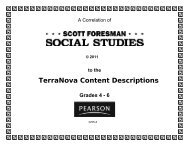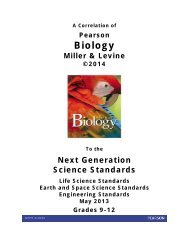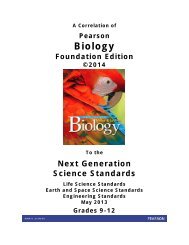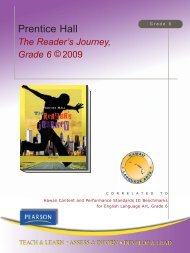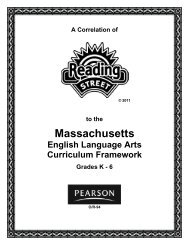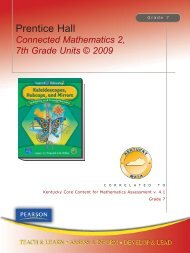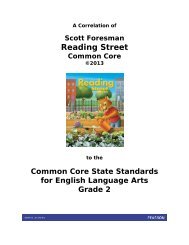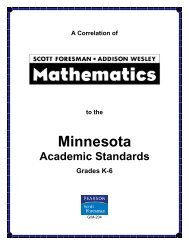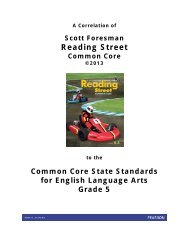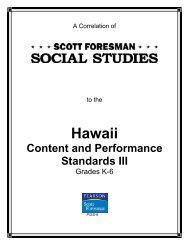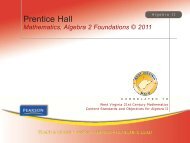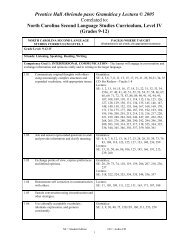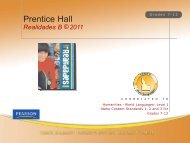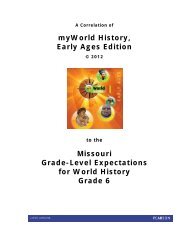Prentice Hall Chemistry © 2008 (Wilbraham) Correlated to ... - Pearson
Prentice Hall Chemistry © 2008 (Wilbraham) Correlated to ... - Pearson
Prentice Hall Chemistry © 2008 (Wilbraham) Correlated to ... - Pearson
Create successful ePaper yourself
Turn your PDF publications into a flip-book with our unique Google optimized e-Paper software.
<strong>Prentice</strong> <strong>Hall</strong> <strong>Chemistry</strong> © <strong>2008</strong> (<strong>Wilbraham</strong>)<strong>Correlated</strong> <strong>to</strong>:Arizona Science Standards, Articulated by Grade Level, Strands 1-6(High School)ARIZONA SCIENCE STANDARDSHIGH SCHOOL (Approved 5/24/04)PAGE(S) WHERE TAUGHT(If submission is not a text, cite appropriate resource(s))Strand 1: Inquiry ProcessInquiry Process establishes the basis for students’ learning in science. Students use scientific processes:questioning, planning and conducting investigations, using appropriate <strong>to</strong>ols and techniques <strong>to</strong> gather data,thinking critically and logically about relationships between evidence and explanations, and communicatingresults.Concept 1: Observations, Questions, and Hypotheses: Formulate predictions, questions, or hypotheses basedon observations. Evaluate appropriate resources.PO 1.PO 2.Evaluate scientific information for relevance<strong>to</strong> a given problem.Develop questions from observations thattransition in<strong>to</strong> testable hypotheses.SE/TE: Thinking Like a Scientist, 20-25; ConceptualProblems, 32, 46, 51, 68, 111, 113, 116, 135,167, 193, 196, 220, 225, 239, 256, 263, 265,324, 327, 328, 331, 332, 334, 335, 337, 343,358, 507, 593, 622, 634, 641, 643, 647, 649,677, 697, 699, 700, 706; Inquiry Activities, 6,38, 62, 100, 126, 154, 186, 212, 252, 286,320, 352, 384, 412, 444, 470, 504, 540, 586,630, 662, 692, 724, 762, 798; Quick Labs, 23,45, 72, 87, 108, 142, 175, 199, 226, 279, 308,326, 372, 402, 428, 448, 489, 522, 544, 604,653, 683, 707, 746, 780, 818; Small-ScaleLabs, 26-27, 56, 94, 120, 137, 179, 200, 245,267, 304, 345, 367, 400, 437, 458, 497, 533,574, 617, 606, 684, 708, 753, 774, 809TE: 6A-6BLM: throughout Labs #1-#52SSLM: throughout Labs #1-#41TR: GRSW 1.3; CTR 1.3TECH: T5-T6; iT 1.3; GO 1.3SE/TE: The Scientific Method, 22-23; InquiryActivities, 6, 412, 444, 630; Quick Labs, 23TE: 6A-6BLM: Develop a Hypothesis, 32, 36, 44, 47, 62, 66,77, 84, 90, 96, 100, 108, 114, 126, 132, 145,152, 161, 166, 172, 176, 187, 193, 198, 202,209, 216, 223, 230, 235, 241, 246, 250, 254,258, 266, 270, 274, 278, 286, 290, 303, 309,317SSLM: Design an Experiment, 29-30, 76, 81-82, 94,101, 110, 116, 133, 153, 218, 227, 233-234,240, 263-264, 274, 278TR: GRSW 1.3; CTR 1.3TECH: T5-T6; iT 1.3; GO 1.3SE = Student Edition TE = Teacher’s Edition LM = Lab Manual SSLM = Small-Scale Lab ManualTR = Teaching Resources (GRSW = Guided Reading and Study Workbook CTR = Core Teaching Resources)TECH = Technology (T = Transparencies, iT = Interactive Textbook with ChemASAP; GO = Go Online Internet Resources)1
<strong>Prentice</strong> <strong>Hall</strong> <strong>Chemistry</strong> © <strong>2008</strong> (<strong>Wilbraham</strong>)<strong>Correlated</strong> <strong>to</strong>:Arizona Science Standards, Articulated by Grade Level, Strands 1-6, (High School)ARIZONA SCIENCE STANDARDSHIGH SCHOOL (Approved 5/24/04)PAGE(S) WHERE TAUGHT(If submission is not a text, cite appropriate resource(s))PO 3. Formulate a testable hypothesis. SE/TE: The Scientific Method, 22-23; InquiryActivities, 6, 412, 444, 630; Quick Labs, 23TE: 6A-6BLM: Develop a Hypothesis, 32, 36, 44, 47, 62, 66,77, 84, 90, 96, 100, 108, 114, 126, 132, 145,152, 161, 166, 172, 176, 187, 193, 198, 202,209, 216, 223, 230, 235, 241, 246, 250, 254,258, 266, 270, 274, 278, 286, 290, 303, 309,317SSLM: Design an Experiment, 29-30, 76, 81-82, 94,101, 110, 116, 133, 153, 218, 227, 233-234,240, 263-264, 274, 278TR: GRSW 1.3; CTR 1.3TECH: T5-T6; iT 1.3; GO 1.3PO 4.Predict the outcome of an investigation basedon prior evidence, probability, and/ormodeling (not guessing or inferring).SE/TE: Inquiry Activities, 100, 540; Quick Labs, 175,402, 489; Small-Scale Labs, 56, 94, 120, 137,179, 200, 245, 267, 304, 345, 367, 400, 437,458, 497, 533, 574, 617, 606, 684, 708, 753,774, 809LM: (additional opportunities) Labs #1-#52SSLM: (additional opportunities) Labs #1-#41Concept 2: Scientific Testing (Investigating and Modeling): Design and conduct controlled investigations.PO 1.Demonstrate safe and ethical procedures (e.g.,use and care of technology, materials,organisms) and behavior in all scienceinquiry.SE/TE: Labora<strong>to</strong>ry Safety, 26-27; Small-Scale Labs,56, 94, 120, 137, 179, 200, 245, 267, 304,345, 367, 400, 437, 458, 497, 533, 574, 617,606, 684, 708, 753, 774, 809; Appendix E:Safety in the <strong>Chemistry</strong> Labora<strong>to</strong>ry, R90-R91LM: Teacher’s Guide <strong>to</strong> Safe Labora<strong>to</strong>ry Practices,T4-T11; Chemical Waste Disposal, T12-T15;Student Safety Guide, 5-9; Safety First!, 22,26, 33-34, 37, 45, 49-50, 53-54, 57-58, 63, 67,73, 79, 85-86, 92, 98, 102, 110, 117-118, 121-122, 127, 133-134, 139-140, 147-148, 155-156, 163-164, 168, 173-174, 179-180, 183-184, 189-190, 195-196, 199, 203-204, 211-212, 217-218, 226, 231-232, 238, 243-244,248, 251-252, 255-256, 260, 267, 272, 275-276, 280, 288, 291, 299-300, 306, 312; Safetyin the <strong>Chemistry</strong> Labora<strong>to</strong>ry: Safety Quiz 1,T378-T379; Safe Labora<strong>to</strong>ry Techniques:Safety Quiz 2, T380-T381; Safety Contract,T382; Care of Labora<strong>to</strong>ry Equipment, T383-T385SE = Student Edition TE = Teacher’s Edition LM = Lab Manual SSLM = Small-Scale Lab ManualTR = Teaching Resources (GRSW = Guided Reading and Study Workbook CTR = Core Teaching Resources)TECH = Technology (T = Transparencies, iT = Interactive Textbook with ChemASAP; GO = Go Online Internet Resources)2
<strong>Prentice</strong> <strong>Hall</strong> <strong>Chemistry</strong> © <strong>2008</strong> (<strong>Wilbraham</strong>)<strong>Correlated</strong> <strong>to</strong>:Arizona Science Standards, Articulated by Grade Level, Strands 1-6, (High School)PO 2.PO 3.ARIZONA SCIENCE STANDARDSHIGH SCHOOL (Approved 5/24/04)Evaluate whether investigational data suppor<strong>to</strong>r do not support the proposed hypothesis.Critique reports of scientific studies (e.g.,published papers, student reports).PAGE(S) WHERE TAUGHT(If submission is not a text, cite appropriate resource(s))SE/TE: Analyze, 26-27, 56, 94, 120, 137, 179, 200,245, 267, 304, 345, 367, 400, 437, 458, 497,533, 574, 617, 606, 684, 708, 753, 774, 809LM: Analyses and Conclusions, 23-24, 30-31, 35-36, 40-44, 47, 51-52, 55-56, 59-61, 65-66, 70-71, 81-83, 88-90, 94-96, 99-100, 106-107,112-114, 119-120, 124-126, 129-132, 137-138, 143-145, 150-152, 158-161, 165-166,171, 175-176, 181-182, 186-187, 192-193,197-198, 201-202, 206-209, 214-216, 220-223, 229-230, 234-235, 239-240, 245-246,250, 253-254, 257-258, 264-266, 269-270,273-274, 277-278, 284-286, 289-290, 301-302, 308, 316SSLM: Questions for Analyses, 20-21, 28, 37-38, 44-46, 50-51, 55-56, 61, 66-67, 72, 75-76, 80-81,88, 93-94, 99-101, 108-109, 115-116, 124-126, 132-133, 137-138, 144, 151-153, 160-161, 168, 174-176, 180-181, 188-189, 194-195, 202, 208-210, 218, 224-226, 232-233,240, 246-247, 254-255, 262-263, 269, 274,278, 283-284, 290-291SE/TE: (opportunities) Technology & Society, 18-19,43, 88, 109, 147, 168-169, 204-205, 242, 259,313, 340-341, 376-377, 405, 430-431, 463,478-479, 518-519, 548, 623, 644, 685, 716-717, 754-755, 791, 814-815LM: Analyses and Conclusions, 23-24, 30-31, 35-36, 40-44, 47, 51-52, 55-56, 59-61, 65-66, 70-71, 81-83, 88-90, 94-96, 99-100, 106-107,112-114, 119-120, 124-126, 129-132, 137-138, 143-145, 150-152, 158-161, 165-166,171, 175-176, 181-182, 186-187, 192-193,197-198, 201-202, 206-209, 214-216, 220-223, 229-230, 234-235, 239-240, 245-246,250, 253-254, 257-258, 264-266, 269-270,273-274, 277-278, 284-286, 289-290, 301-302, 308, 316SSLM: Questions for Analyses, 20-21, 28, 37-38, 44-46, 50-51, 55-56, 61, 66-67, 72, 75-76, 80-81,88, 93-94, 99-101, 108-109, 115-116, 124-126, 132-133, 137-138, 144, 151-153, 160-161, 168, 174-176, 180-181, 188-189, 194-195, 202, 208-210, 218, 224-226, 232-233,240, 246-247, 254-255, 262-263, 269, 274,278, 283-284, 290-291SE = Student Edition TE = Teacher’s Edition LM = Lab Manual SSLM = Small-Scale Lab ManualTR = Teaching Resources (GRSW = Guided Reading and Study Workbook CTR = Core Teaching Resources)TECH = Technology (T = Transparencies, iT = Interactive Textbook with ChemASAP; GO = Go Online Internet Resources)5
<strong>Prentice</strong> <strong>Hall</strong> <strong>Chemistry</strong> © <strong>2008</strong> (<strong>Wilbraham</strong>)<strong>Correlated</strong> <strong>to</strong>:Arizona Science Standards, Articulated by Grade Level, Strands 1-6, (High School)PO 4.PO 5.PO 6.PO 7.ARIZONA SCIENCE STANDARDSHIGH SCHOOL (Approved 5/24/04)Evaluate the design of an investigation <strong>to</strong>identify possible sources of procedural error,including:• sample size• trials• controls• analysesDesign models (conceptual or physical) of thefollowing <strong>to</strong> represent "real world" scenarios:• carbon cycle• water cycle• phase change• collisionsUse descriptive statistics <strong>to</strong> analyze data,including:• mean• frequency• range (See MHS-S2C1-10)Propose further investigations based on thefindings of a conducted investigation.PAGE(S) WHERE TAUGHT(If submission is not a text, cite appropriate resource(s))SE/TE: Analyze, 26-27, 56, 94, 120, 137, 179, 200,245, 267, 304, 345, 367, 400, 437, 458, 497,533, 574, 617, 606, 684, 708, 753, 774, 809LM: Analyses and Conclusions, 23-24, 30-31, 35-36, 40-44, 47, 51-52, 55-56, 59-61, 65-66, 70-71, 81-83, 88-90, 94-96, 99-100, 106-107,112-114, 119-120, 124-126, 129-132, 137-138, 143-145, 150-152, 158-161, 165-166,171, 175-176, 181-182, 186-187, 192-193,197-198, 201-202, 206-209, 214-216, 220-223, 229-230, 234-235, 239-240, 245-246,250, 253-254, 257-258, 264-266, 269-270,273-274, 277-278, 284-286, 289-290, 301-302, 308, 316SSLM: Questions for Analyses, 20-21, 28, 37-38, 44-46, 50-51, 55-56, 61, 66-67, 72, 75-76, 80-81,88, 93-94, 99-101, 108-109, 115-116, 124-126, 132-133, 137-138, 144, 151-153, 160-161, 168, 174-176, 180-181, 188-189, 194-195, 202, 208-210, 218, 224-226, 232-233,240, 246-247, 254-255, 262-263, 269, 274,278, 283-284, 290-291SE/TE: Energy and Carbon Cycle, 764-765SE/TE: Water and Its Properties, 445-449SE/TE: Phase Diagrams, 402-404TE: 384A-384BLM: Exp #22: Changes of Physical State, 139-145TR: GRSW 13.4; CTR 13.4TECH: T148-T149; iT 13.4; GO 13.4SE/TE: 386, 541, 542-544SE/TE: (<strong>to</strong>pics related <strong>to</strong> <strong>Chemistry</strong>) Problem Solvingin <strong>Chemistry</strong>, 28-32; see also Appendix C:Math Handbook, R56-R79SE/TE: You’re the Chemist, 56, 94, 120, 137, 179,200, 245, 267, 304, 345, 367, 400, 437, 458,497, 533, 574, 617, 606, 684, 708, 753, 774,809LM: Going Further, 24, 32, 36, 44, 47-48, 52, 56,62, 66, 71, 77, 84, 90, 96, 100, 108, 114-115,120, 126, 132, 138, 145, 152, 161, 166, 172,176-177, 182, 187, 193, 198, 202, 209, 216,223, 230, 235, 241, 246, 250, 254, 258, 266,270, 274, 278, 286, 290, 297, 303, 309, 317SE = Student Edition TE = Teacher’s Edition LM = Lab Manual SSLM = Small-Scale Lab ManualTR = Teaching Resources (GRSW = Guided Reading and Study Workbook CTR = Core Teaching Resources)TECH = Technology (T = Transparencies, iT = Interactive Textbook with ChemASAP; GO = Go Online Internet Resources)6
<strong>Prentice</strong> <strong>Hall</strong> <strong>Chemistry</strong> © <strong>2008</strong> (<strong>Wilbraham</strong>)<strong>Correlated</strong> <strong>to</strong>:Arizona Science Standards, Articulated by Grade Level, Strands 1-6, (High School)PO 7.ARIZONA SCIENCE STANDARDSHIGH SCHOOL (Approved 5/24/04)(Continued)Propose further investigations based on thefindings of a conducted investigation.PAGE(S) WHERE TAUGHT(If submission is not a text, cite appropriate resource(s))(Continued)SSLM: Now It’s Your Turn!, 21, 29-30, 38-39, 46,51-52, 56, 62, 67-68, 72, 76, 81-82, 89-90, 94,101, 110, 116, 126, 133, 138-139, 144, 153,161-162, 168, 175, 181, 189-190, 195, 202,211-212, 218, 227, 233-234, 240, 247, 255-256, 263-264, 269-270, 274, 278, 285Concept 4: Communication: Communicate results of investigations.PO 1.PO 2.For a specific investigation, choose anappropriate method for communicating theresults.Produce graphs that communicate data. (SeeMHS-S2C1-02)SE/TE: Inquiry Activities: Think About It, 6, 38, 62,100, 126, 154, 186, 212, 252, 286, 320, 352,384, 412, 444, 470, 504, 540, 586, 630, 662,692, 724, 762, 798; Quick Labs: Analyze andConclude, 23, 45, 72, 87, 108, 142, 175, 199,226, 279, 308, 326, 372, 402, 428, 448, 489,522, 544, 604, 653, 683, 707, 746, 780, 818;Small-Scale Labs: Analyze, 56, 94, 120, 137,179, 200, 245, 267, 304, 345, 367, 400, 437,458, 497, 533, 574, 617, 606, 684, 708, 753,774, 809LM: Analyses and Conclusions, 23-24, 30-31, 35-36, 41-44, 47, 51-52, 55-56, 59-61, 66, 70-71,81-83, 88-90, 94-96, 99-100, 106-107, 112-114, 119-120, 124-126, 129-132, 137-138,144-145, 150-152, 158-161, 165-166, 171,175-176, 181-182, 186-187, 192-193, 197-198, 201-202, 206-209, 214-216, 220-223,229-230, 234-235, 239-240, 245-246, 250,253-254, 257-258, 264-266, 269-270, 273-274, 277-278, 284-286, 289-290, 301-302,308, 316; Sample Labora<strong>to</strong>ry Report, 319-321SSLM: Questions for Analyses, 20-21, 28, 37-38, 44-46, 50-51, 55-56, 61, 66-67, 72, 75-76, 80-81,88, 93-94, 99-101, 108-109, 115-116, 124-126, 132-133, 137-138, 144, 151-153, 160-161, 168, 174-176, 180-181, 188-189, 194-195, 202, 208-210, 218, 224-226, 232-233,240, 246-247, 254-255, 262-263, 269, 274,278, 283-284, 290-291SE/TE: Quick Labs, 175, 818; Small-Scale Labs, 809;Interpreting Graphs, 16, 171, 174, 388, 394,403, 418, 420, 429, 474, 523, 543, 547, 550,576, 578, 602, 606, 618, 803, 804; MathHandbook, R74-R77LM: Analyses and Conclusions, 40-44, 59-61, 65-66, 129-132, 143-145, 152-153, 158-161, 206-209, 234-236, 315-316SE = Student Edition TE = Teacher’s Edition LM = Lab Manual SSLM = Small-Scale Lab ManualTR = Teaching Resources (GRSW = Guided Reading and Study Workbook CTR = Core Teaching Resources)TECH = Technology (T = Transparencies, iT = Interactive Textbook with ChemASAP; GO = Go Online Internet Resources)7
<strong>Prentice</strong> <strong>Hall</strong> <strong>Chemistry</strong> © <strong>2008</strong> (<strong>Wilbraham</strong>)<strong>Correlated</strong> <strong>to</strong>:Arizona Science Standards, Articulated by Grade Level, Strands 1-6, (High School)ARIZONA SCIENCE STANDARDSHIGH SCHOOL (Approved 5/24/04)PAGE(S) WHERE TAUGHT(If submission is not a text, cite appropriate resource(s))PO 3. Communicate results clearly and logically. SE/TE: Inquiry Activities: Think About It, 6, 38, 62,100, 126, 154, 186, 212, 252, 286, 320, 352,384, 412, 444, 470, 504, 540, 586, 630, 662,692, 724, 762, 798; Quick Labs: Analyze andConclude, 23, 45, 72, 87, 108, 142, 175, 199,226, 279, 308, 326, 372, 402, 428, 448, 489,522, 544, 604, 653, 683, 707, 746, 780, 818;Small-Scale Labs: Analyze, 56, 94, 120, 137,179, 200, 245, 267, 304, 345, 367, 400, 437,458, 497, 533, 574, 617, 606, 684, 708, 753,774, 809LM: Analyses and Conclusions, 23-24, 30-31, 35-36, 41-44, 47, 51-52, 55-56, 59-61, 66, 70-71,81-83, 88-90, 94-96, 99-100, 106-107, 112-114, 119-120, 124-126, 129-132, 137-138,144-145, 150-152, 158-161, 165-166, 171,175-176, 181-182, 186-187, 192-193, 197-198, 201-202, 206-209, 214-216, 220-223,229-230, 234-235, 239-240, 245-246, 250,253-254, 257-258, 264-266, 269-270, 273-274, 277-278, 284-286, 289-290, 301-302,308, 316; Sample Labora<strong>to</strong>ry Report, 319-321SSLM: Questions for Analyses, 20-21, 28, 37-38, 44-46, 50-51, 55-56, 61, 66-67, 72, 75-76, 80-81,88, 93-94, 99-101, 108-109, 115-116, 124-126, 132-133, 137-138, 144, 151-153, 160-161, 168, 174-176, 180-181, 188-189, 194-195, 202, 208-210, 218, 224-226, 232-233,240, 246-247, 254-255, 262-263, 269, 274,278, 283-284, 290-291PO 4.Support conclusions with logical scientificarguments.SE/TE: Inquiry Activities: Think About It, 6, 38, 62,100, 126, 154, 186, 212, 252, 286, 320, 352,384, 412, 444, 470, 504, 540, 586, 630, 662,692, 724, 762, 798; Quick Labs: Analyze andConclude, 23, 45, 72, 87, 108, 142, 175, 199,226, 279, 308, 326, 372, 402, 428, 448, 489,522, 544, 604, 653, 683, 707, 746, 780, 818;Small-Scale Labs: Analyze, 56, 94, 120, 137,179, 200, 245, 267, 304, 345, 367, 400, 437,458, 497, 533, 574, 617, 606, 684, 708, 753,774, 809SE = Student Edition TE = Teacher’s Edition LM = Lab Manual SSLM = Small-Scale Lab ManualTR = Teaching Resources (GRSW = Guided Reading and Study Workbook CTR = Core Teaching Resources)TECH = Technology (T = Transparencies, iT = Interactive Textbook with ChemASAP; GO = Go Online Internet Resources)8
<strong>Prentice</strong> <strong>Hall</strong> <strong>Chemistry</strong> © <strong>2008</strong> (<strong>Wilbraham</strong>)<strong>Correlated</strong> <strong>to</strong>:Arizona Science Standards, Articulated by Grade Level, Strands 1-6, (High School)PO 4.ARIZONA SCIENCE STANDARDSHIGH SCHOOL (Approved 5/24/04)(Continued)Support conclusions with logical scientificarguments.PAGE(S) WHERE TAUGHT(If submission is not a text, cite appropriate resource(s))(Continued)LM: Analyses and Conclusions, 23-24, 30-31, 35-36, 41-44, 47, 51-52, 55-56, 59-61, 66, 70-71,81-83, 88-90, 94-96, 99-100, 106-107, 112-114, 119-120, 124-126, 129-132, 137-138,144-145, 150-152, 158-161, 165-166, 171,175-176, 181-182, 186-187, 192-193, 197-198, 201-202, 206-209, 214-216, 220-223,229-230, 234-235, 239-240, 245-246, 250,253-254, 257-258, 264-266, 269-270, 273-274, 277-278, 284-286, 289-290, 301-302,308, 316; Sample Labora<strong>to</strong>ry Report, 319-321SSLM: Questions for Analyses, 20-21, 28, 37-38, 44-46, 50-51, 55-56, 61, 66-67, 72, 75-76, 80-81,88, 93-94, 99-101, 108-109, 115-116, 124-126, 132-133, 137-138, 144, 151-153, 160-161, 168, 174-176, 180-181, 188-189, 194-195, 202, 208-210, 218, 224-226, 232-233,240, 246-247, 254-255, 262-263, 269, 274,278, 283-284, 290-291Strand 2: His<strong>to</strong>ry and Nature of ScienceScientific investigation grows from the contributions of many people. His<strong>to</strong>ry and Nature of Science emphasizesthe importance of the inclusion of his<strong>to</strong>rical perspectives and the advances that each new development brings <strong>to</strong>technology and human knowledge. This strand focuses on the human aspects of science and the role thatscientists play in the development of various cultures.Concept 1: His<strong>to</strong>ry of Science as a Human Endeavor: Identify individual, cultural, and technologicalcontributions <strong>to</strong> scientific knowledge.PO 1.PO 2.Describe how human curiosity and needs haveinfluenced science, impacting the quality oflife worldwide.Describe how diverse people and/or cultures,past and present, have made importantcontributions <strong>to</strong> scientific innovations.SE/TE: <strong>Chemistry</strong>, 7-11; <strong>Chemistry</strong> Far and Wide, 12-17; Thinking Like a Scientist, 20-25; see alsoCareers in <strong>Chemistry</strong>, 93, 119, 146, 256, 329,404, 514, 579, 611, 701; Technology &Society, 18-19, 43, 88, 109, 147, 168-169,204-205, 242, 259, 313, 340-341, 376-377,405, 430-431, 463, 478-479, 518-519, 548,623, 644, 685, 716-717, 754-755, 791, 814-815TE: 6A-6BTR: GRSW 1.1-1.3; CTR 1.1-1.3TECH: T1-T6; iT 1.1-1.3; GO 1.1, 1.3SE/TE: Careers in <strong>Chemistry</strong>, 93, 119, 146, 256, 329,404, 514, 579, 611, 701; Technology &Society, 18-19, 43, 88, 109, 147, 168-169,204-205, 242, 259, 313, 340-341, 376-377,405, 430-431, 463, 478-479, 518-519, 548,623, 644, 685, 716-717, 754-755, 791, 814-815SE = Student Edition TE = Teacher’s Edition LM = Lab Manual SSLM = Small-Scale Lab ManualTR = Teaching Resources (GRSW = Guided Reading and Study Workbook CTR = Core Teaching Resources)TECH = Technology (T = Transparencies, iT = Interactive Textbook with ChemASAP; GO = Go Online Internet Resources)9
<strong>Prentice</strong> <strong>Hall</strong> <strong>Chemistry</strong> © <strong>2008</strong> (<strong>Wilbraham</strong>)<strong>Correlated</strong> <strong>to</strong>:Arizona Science Standards, Articulated by Grade Level, Strands 1-6, (High School)PO 3.PO 4.ARIZONA SCIENCE STANDARDSHIGH SCHOOL (Approved 5/24/04)Analyze how specific changes in science haveaffected society.Analyze how specific cultural and/or societalissues promote or hinder scientificadvancements.PAGE(S) WHERE TAUGHT(If submission is not a text, cite appropriate resource(s))SE/TE: Technology & Society, 18-19, 43, 88, 109,147, 168-169, 204-205, 242, 259, 313, 340-341, 376-377, 405, 430-431, 463, 478-479,518-519, 548, 623, 644, 685, 716-717, 754-755, 791, 814-815SE/TE: <strong>Chemistry</strong>, 7-11; <strong>Chemistry</strong> Far and Wide, 12-17; Thinking Like a Scientist, 20-25; see alsoCareers in <strong>Chemistry</strong>, 93, 119, 146, 256, 329,404, 514, 579, 611, 701; Technology &Society, 18-19, 43, 88, 109, 147, 168-169,204-205, 242, 259, 313, 340-341, 376-377,405, 430-431, 463, 478-479, 518-519, 548,623, 644, 685, 716-717, 754-755, 791, 814-815TE: 6A-6BTR: GRSW 1.1-1.3; CTR 1.1-1.3TECH: T1-T6; iT 1.1-1.3; GO 1.1, 1.3Concept 2: Nature of Scientific Knowledge: Understand how science is a process for generating knowledge.PO 1.PO 2.Specify the requirements of a valid, scientificexplanation (theory), including that it be:• logical• subject <strong>to</strong> peer review• public• respectful of rules of evidenceExplain the process by which accepted ideasare challenged or extended by scientificinnovation.SE/TE: Thinking Like a Scientist, 20-25TE: 6A-6BTR: GRSW 1.3; CTR 1.3TECH: T5-T6; iT 1.3; GO 1.3SE/TE: <strong>Chemistry</strong>, 7-11; <strong>Chemistry</strong> Far and Wide, 12-17; Thinking Like a Scientist, 20-25TE: 6A-6BTR: GRSW 1.1-1.3; CTR 1.1-1.3TECH: T1-T6; iT 1.1-1.3; GO 1.1, 1.3PO 3. Distinguish between pure and applied science. SE/TE: Pure and Applied <strong>Chemistry</strong>, 9, 11TE: 6A-6BTR: GRSW 1.1; CTR 1.1TECH: T1-T2; iT 1.1; GO 1.1PO 4.Describe how scientists continue <strong>to</strong>investigate and critically analyze aspects oftheories.SE/TE: Thinking Like a Scientist, 20-25TE: 6A-6BTR: GRSW 1.3; CTR 1.3TECH: T5-T6; iT 1.3; GO 1.3SE = Student Edition TE = Teacher’s Edition LM = Lab Manual SSLM = Small-Scale Lab ManualTR = Teaching Resources (GRSW = Guided Reading and Study Workbook CTR = Core Teaching Resources)TECH = Technology (T = Transparencies, iT = Interactive Textbook with ChemASAP; GO = Go Online Internet Resources)10
<strong>Prentice</strong> <strong>Hall</strong> <strong>Chemistry</strong> © <strong>2008</strong> (<strong>Wilbraham</strong>)<strong>Correlated</strong> <strong>to</strong>:Arizona Science Standards, Articulated by Grade Level, Strands 1-6, (High School)ARIZONA SCIENCE STANDARDSHIGH SCHOOL (Approved 5/24/04)PAGE(S) WHERE TAUGHT(If submission is not a text, cite appropriate resource(s))Strand 3: Science in Personal and Social PerspectivesScience in Personal and Social Perspectives emphasizes developing the ability <strong>to</strong> design a solution <strong>to</strong> a problem,<strong>to</strong> understand the relationship between science and technology, and the ways people are involved in both.Students understand the impact of science and technology on human activity and the environment. This strandaffords students the opportunity <strong>to</strong> understand their place in the world – as living creatures, consumers, decisionmakers, problem solvers, managers, and planners.Concept 1: Changes in Environments: Describe the interactions between human populations, natural hazards,and the environment.PO 1.PO 2.PO 3.PO 4.PO 5.Evaluate how the processes of naturalecosystems affect, and are affected by,humans.Describe the environmental effects of thefollowing natural and/or human-causedhazards:• flooding• drought• earthquakes• fires• pollution• extreme weatherAssess how human activities (e.g., clearcutting, water management, tree thinning) canaffect the potential for hazards.Evaluate the following fac<strong>to</strong>rs that affect thequality of the environment:• urban development• smoke• volcanic dustEvaluate the effectiveness of conservationpractices and preservation techniques onenvironmental quality and biodiversity.SE/TE: <strong>Chemistry</strong> Far and Wide, 12-17TE: 6A-6BTR: GRSW 1.2; CTR 1.2TECH: T3-T4; iT 1.2SE/TE: The Environment, 16, 17, 463TE: 6A-6BTR: GRSW 1.2; CTR 1.2TECH: T3-T4; iT 1.2SE/TE: Agriculture, 15, 17TE: 6A-6BTR: GRSW 1.2; CTR 1.2TECH: T3-T4; iT 1.2SE/TE: The Environment, 16, 17, 463TE: 6A-6BTR: GRSW 1.2; CTR 1.2TECH: T3-T4; iT 1.2SE/TE: <strong>Chemistry</strong> Far and Wide, 12-17; Technology& Society: Nature’s Pharmacy, 18-19; WaterWorth Drinking, 463; Solar Power Plants,518-519TE: 6A-6BTR: GRSW 1.2; CTR 1.2TECH: T3-T4; iT 1.2SE = Student Edition TE = Teacher’s Edition LM = Lab Manual SSLM = Small-Scale Lab ManualTR = Teaching Resources (GRSW = Guided Reading and Study Workbook CTR = Core Teaching Resources)TECH = Technology (T = Transparencies, iT = Interactive Textbook with ChemASAP; GO = Go Online Internet Resources)11
<strong>Prentice</strong> <strong>Hall</strong> <strong>Chemistry</strong> © <strong>2008</strong> (<strong>Wilbraham</strong>)<strong>Correlated</strong> <strong>to</strong>:Arizona Science Standards, Articulated by Grade Level, Strands 1-6, (High School)ARIZONA SCIENCE STANDARDSHIGH SCHOOL (Approved 5/24/04)PAGE(S) WHERE TAUGHT(If submission is not a text, cite appropriate resource(s))Concept 2: Science and Technology in Society: Develop viable solutions <strong>to</strong> a need or problem.PO 1.Analyze the costs, benefits, and risks ofvarious ways of dealing with the followingneeds or problems:• various forms of alternative energy• s<strong>to</strong>rage of nuclear waste• abandoned mines• greenhouse gases• hazardous wastesSE/TE: Technology & Society: Solar Power Plants,518-519; A Number You Can’t Knock, 716-717; Elements Handbook: A HydrogenEconomy, R39SE/TE: Nuclear Waste, 812, 813; ElementsHandbook: Heavy Water Reac<strong>to</strong>rs, R39Fundamental background information and processskills are covered. This performance objective is moredirectly addressed in other <strong>Prentice</strong> <strong>Hall</strong> titles.SE/TE: (related <strong>to</strong>pics) Elements Handbook: Gold,R44SE/TE: Elements Handbook: Greenhouse Gases, R22;Ozone, R31SE/TE: Elements Handbook: Green <strong>Chemistry</strong>, R20;Carbon Monoxide, R23PO 2.PO 3.PO 4.PO 5.Recognize the importance of basingarguments on a thorough understanding of thecore concepts and principles of science andtechnology.Support a position on a science or technologyissue.Analyze the use of renewable andnonrenewable resources in Arizona:• water• land• soil• minerals• airEvaluate methods used <strong>to</strong> manage naturalresources (e.g., reintroduction of wildlife, fireecology).SE/TE: Technology & Society, 18-19, 43, 88, 109,147, 168-169, 204-205, 242, 259, 313, 340-341, 376-377, 405, 430-431, 463, 478-479,518-519, 548, 623, 644, 685, 716-717, 754-755, 791, 814-815SE/TE: Technology & Society, 18-19, 43, 88, 109,147, 168-169, 204-205, 242, 259, 313, 340-341, 376-377, 405, 430-431, 463, 478-479,518-519, 548, 623, 644, 685, 716-717, 754-755, 791, 814-815SE/TE: Technology & Society: Solar Power Plants,518-519; Elements Handbook: GreenhouseGases, R22; Recycling Plastics, R23; Ozone,R31; Acid Rain, R27; Selenium in Food, R30;Transition Metals, R42-R45Fundamental background information and processskills are covered. This performance objective is moredirectly addressed in other <strong>Prentice</strong> <strong>Hall</strong> titles.SE/TE: (related <strong>to</strong>pics) 15, 514SE = Student Edition TE = Teacher’s Edition LM = Lab Manual SSLM = Small-Scale Lab ManualTR = Teaching Resources (GRSW = Guided Reading and Study Workbook CTR = Core Teaching Resources)TECH = Technology (T = Transparencies, iT = Interactive Textbook with ChemASAP; GO = Go Online Internet Resources)12
<strong>Prentice</strong> <strong>Hall</strong> <strong>Chemistry</strong> © <strong>2008</strong> (<strong>Wilbraham</strong>)<strong>Correlated</strong> <strong>to</strong>:Arizona Science Standards, Articulated by Grade Level, Strands 1-6, (High School)ARIZONA SCIENCE STANDARDSHIGH SCHOOL (Approved 5/24/04)PAGE(S) WHERE TAUGHT(If submission is not a text, cite appropriate resource(s))Concept 3: Human Population Characteristics: Analyze fac<strong>to</strong>rs that affect human populations.PO 1.PO 2.PO 3.Analyze social fac<strong>to</strong>rs that limit the growth ofa human population, including:• affluence• education• access <strong>to</strong> health care• cultural influencesDescribe biotic (living) and abiotic(nonliving) fac<strong>to</strong>rs that affect humanpopulations.Predict the effect of a change in a specificfac<strong>to</strong>r on a human population.This performance objective is directly addressed inother <strong>Prentice</strong> <strong>Hall</strong> titles.This performance objective is directly addressed inother <strong>Prentice</strong> <strong>Hall</strong> titles.This performance objective is directly addressed inother <strong>Prentice</strong> <strong>Hall</strong> titles.Strand 4: Life ScienceLife Science expands students’ biological understanding of life by focusing on the characteristics of living things,the diversity of life, and how organisms and populations change over time in terms of biological adaptation andgenetics. This understanding includes the relationship of structures <strong>to</strong> their functions and life cycles,interrelationships of matter and energy in living organisms, and the interactions of living organisms with theirenvironment.Concept 1: The Cell: Understand the role of the cell and cellular processes.PO 1.PO 2.Describe the role of energy in cellular growth,development, and repair.Compare the form and function of prokaryoticand eukaryotic cells and their cellularcomponents.Fundamental background information and processskills are covered. This performance objective is moredirectly addressed in other <strong>Prentice</strong> <strong>Hall</strong> titles.SE/TE: A Strategy for Life, 763-765TE: 762A-762BTR: GRSW 24.1; CTR 24.1TECH: T271-T272; iT 24.1; GO 24.1Fundamental background information and processskills are covered. This performance objective is moredirectly addressed in other <strong>Prentice</strong> <strong>Hall</strong> titles.SE/TE: A Strategy for Life, 763-765TE: 762A-762BTR: GRSW 24.1; CTR 24.1TECH: T271-T272; iT 24.1; GO 24.1PO 3. Explain the importance of water <strong>to</strong> cells. Fundamental background information and processskills are covered. This performance objective is moredirectly addressed in other <strong>Prentice</strong> <strong>Hall</strong> titles.SE/TE: A Strategy for Life, 763-765TE: 762A-762BTR: GRSW 24.1; CTR 24.1TECH: T271-T272; iT 24.1; GO 24.1SE = Student Edition TE = Teacher’s Edition LM = Lab Manual SSLM = Small-Scale Lab ManualTR = Teaching Resources (GRSW = Guided Reading and Study Workbook CTR = Core Teaching Resources)TECH = Technology (T = Transparencies, iT = Interactive Textbook with ChemASAP; GO = Go Online Internet Resources)13
<strong>Prentice</strong> <strong>Hall</strong> <strong>Chemistry</strong> © <strong>2008</strong> (<strong>Wilbraham</strong>)<strong>Correlated</strong> <strong>to</strong>:Arizona Science Standards, Articulated by Grade Level, Strands 1-6, (High School)PO 4.PO 5.ARIZONA SCIENCE STANDARDSHIGH SCHOOL (Approved 5/24/04)Analyze mechanisms of transport of materials(e.g., water, ions, macromolecules) in<strong>to</strong> andout of cells:·• passive transport• active transportDescribe the purposes and processes ofcellular reproduction.PAGE(S) WHERE TAUGHT(If submission is not a text, cite appropriate resource(s))This performance objective is directly addressed inother <strong>Prentice</strong> <strong>Hall</strong> titles.This performance objective is directly addressed inother <strong>Prentice</strong> <strong>Hall</strong> titles.Concept 2: Molecular Basis of Heredity: Understand the molecular basis of heredity and resulting geneticdiversity.PO 1.PO 2.PO 3.PO 4.Analyze the relationships among nucleic acids(DNA, RNA), genes, and chromosomes.Describe the molecular basis of heredity, inviruses and living things, including DNAreplication and protein synthesis.Explain how genotypic variation occurs andresults in phenotypic diversity.Describe how meiosis and fertilizationmaintain genetic variation.Fundamental background information and processskills are covered. This performance objective is moredirectly addressed in other <strong>Prentice</strong> <strong>Hall</strong> titles.SE/TE: Nucleic Acids, 778-785TE: 762A-762BTR: GRSW 24.5; CTR 24.5TECH: T281-T284; iT 24.5; GO 24.5Fundamental background information and processskills are covered. This performance objective is moredirectly addressed in other <strong>Prentice</strong> <strong>Hall</strong> titles.SE/TE: Nucleic Acids, 778-785TE: 762A-762BTR: GRSW 24.5; CTR 24.5TECH: T281-T284; iT 24.5; GO 24.5Fundamental background information and processskills are covered. This performance objective is moredirectly addressed in other <strong>Prentice</strong> <strong>Hall</strong> titles.SE/TE: Nucleic Acids, 778-785TE: 762A-762BTR: GRSW 24.5; CTR 24.5TECH: T281-T284; iT 24.5; GO 24.5Fundamental background information and processskills are covered. This performance objective is moredirectly addressed in other <strong>Prentice</strong> <strong>Hall</strong> titles.SE/TE: Nucleic Acids, 778-785TE: 762A-762BTR: GRSW 24.5; CTR 24.5TECH: T281-T284; iT 24.5; GO 24.5Concept 3: Interdependence of Organisms: Analyze the relationships among various organisms and theirenvironment.PO 1.Identify the relationships among organismswithin populations, communities, ecosystems,and biomes.This performance objective is directly addressed inother <strong>Prentice</strong> <strong>Hall</strong> titles.SE = Student Edition TE = Teacher’s Edition LM = Lab Manual SSLM = Small-Scale Lab ManualTR = Teaching Resources (GRSW = Guided Reading and Study Workbook CTR = Core Teaching Resources)TECH = Technology (T = Transparencies, iT = Interactive Textbook with ChemASAP; GO = Go Online Internet Resources)14
<strong>Prentice</strong> <strong>Hall</strong> <strong>Chemistry</strong> © <strong>2008</strong> (<strong>Wilbraham</strong>)<strong>Correlated</strong> <strong>to</strong>:Arizona Science Standards, Articulated by Grade Level, Strands 1-6, (High School)PO 2.PO 3.ARIZONA SCIENCE STANDARDSHIGH SCHOOL (Approved 5/24/04)Describe how organisms are influenced by aparticular combination of biotic (living) andabiotic (nonliving) fac<strong>to</strong>rs in an environment.Assess how the size and the rate of growth ofa population are determined by birth rate,death rate, immigration, emigration, andcarrying capacity of the environment.PAGE(S) WHERE TAUGHT(If submission is not a text, cite appropriate resource(s))This performance objective is directly addressed inother <strong>Prentice</strong> <strong>Hall</strong> titles.This performance objective is directly addressed inother <strong>Prentice</strong> <strong>Hall</strong> titles.Concept 4: Biological Evolution: Understand the scientific principles and processes involved in biologicalevolution.PO 1.PO 2.PO 3.PO 4.PO 5.Identify the following components of naturalselection, which can lead <strong>to</strong> speciation:• potential for a species <strong>to</strong> increase itsnumbers• genetic variability and inheritance ofoffspring due <strong>to</strong> mutation andrecombination of genes• finite supply of resources required for life• selection by the environment of thoseoffspring better able <strong>to</strong> survive and produceoffspringExplain how genotypic and phenotypicvariation can result in adaptations thatinfluence an organism’s success in anenvironment.Describe how the continuing operation ofnatural selection underlies a population’sability <strong>to</strong> adapt <strong>to</strong> changes in the environmentand leads <strong>to</strong> biodiversity and the origin of newspecies.Predict how a change in an environmentalfac<strong>to</strong>r (e.g., rainfall, habitat loss, non-nativespecies) can affect the number and diversity ofspecies in an ecosystem.Analyze how patterns in the fossil record,nuclear chemistry, geology, molecularbiology, and geographical distribution givesupport <strong>to</strong> the theory of organic evolutionthrough natural selection over billions of yearsand the resulting present day biodiversity.Fundamental background information and processskills are covered. This performance objective is moredirectly addressed in other <strong>Prentice</strong> <strong>Hall</strong> titles.SE/TE: Nucleic Acids, 778-785TE: 762A-762BTR: GRSW 24.5; CTR 24.5TECH: T281-T284; iT 24.5; GO 24.5This performance objective is directly addressed inother <strong>Prentice</strong> <strong>Hall</strong> titles.This performance objective is directly addressed inother <strong>Prentice</strong> <strong>Hall</strong> titles.This performance objective is directly addressed inother <strong>Prentice</strong> <strong>Hall</strong> titles.This performance objective is directly addressed inother <strong>Prentice</strong> <strong>Hall</strong> titles.SE = Student Edition TE = Teacher’s Edition LM = Lab Manual SSLM = Small-Scale Lab ManualTR = Teaching Resources (GRSW = Guided Reading and Study Workbook CTR = Core Teaching Resources)TECH = Technology (T = Transparencies, iT = Interactive Textbook with ChemASAP; GO = Go Online Internet Resources)15
<strong>Prentice</strong> <strong>Hall</strong> <strong>Chemistry</strong> © <strong>2008</strong> (<strong>Wilbraham</strong>)<strong>Correlated</strong> <strong>to</strong>:Arizona Science Standards, Articulated by Grade Level, Strands 1-6, (High School)PO 6.ARIZONA SCIENCE STANDARDSHIGH SCHOOL (Approved 5/24/04)Analyze, using a biological classificationsystem (i.e., cladistics, phylogeny,morphology, DNA analysis), the degree ofrelatedness among various species.PAGE(S) WHERE TAUGHT(If submission is not a text, cite appropriate resource(s))This performance objective is directly addressed inother <strong>Prentice</strong> <strong>Hall</strong> titles.Concept 5: Matter, Energy, and Organization in Living Systems (Including Human Systems): Understandthe organization of living systems, and the role of energy within those systems.PO 1.PO 2.PO 3.PO 4.PO 5.Compare the processes of pho<strong>to</strong>synthesis andcellular respiration in terms of energy flow,reactants, and products.Describe the role of organic and inorganicchemicals (e.g., carbohydrates, proteins,lipids, nucleic acids, water, ATP) important <strong>to</strong>living things.Diagram the following biogeochemical cyclesin an ecosystem:• water• carbon• nitrogenDiagram the energy flow in an ecosystemthrough a food chain.Describe the levels of organization of livingthings from cells, through tissues, organs,organ systems, organisms, populations, andcommunities <strong>to</strong> ecosystems.Fundamental background information and processskills are covered. This performance objective is moredirectly addressed in other <strong>Prentice</strong> <strong>Hall</strong> titles.SE/TE: A Strategy for Life, 763-765TE: 762A-762BTR: GRSW 24.1; CTR 24.1TECH: T271-T272; iT 24.1; GO 24.1SE/TE: Carbohydrates, 766-768; Amino Acids andTheir Polymers, 769-773; Lipids, 775-777;Nucleic Acids, 778-785; Metabolism, 786-790TE: 762A-762BTR: GRSW 24.1-24.6; CTR 24.1-24.6TECH: T271-T272; iT 24.1-24.6; GO 24.1-24.6Fundamental background information and processskills are covered. This performance objective is moredirectly addressed in other <strong>Prentice</strong> <strong>Hall</strong> titles.SE/TE: (<strong>to</strong>pics related <strong>to</strong> <strong>Chemistry</strong>) Water and ItsProperties, 445-449SE/TE: (<strong>to</strong>pics related <strong>to</strong> <strong>Chemistry</strong>) Energy andCarbon Cycle, 764-765SE/TE: (<strong>to</strong>pics related <strong>to</strong> <strong>Chemistry</strong>) The NitrogenCycle, 789-790Fundamental background information and processskills are covered. This performance objective is moredirectly addressed in other <strong>Prentice</strong> <strong>Hall</strong> titles.SE/TE: Energy and Carbon Cycle, 764-765; TheNitrogen Cycle, 789-790This performance objective is directly addressed inother <strong>Prentice</strong> <strong>Hall</strong> titles.SE = Student Edition TE = Teacher’s Edition LM = Lab Manual SSLM = Small-Scale Lab ManualTR = Teaching Resources (GRSW = Guided Reading and Study Workbook CTR = Core Teaching Resources)TECH = Technology (T = Transparencies, iT = Interactive Textbook with ChemASAP; GO = Go Online Internet Resources)16
<strong>Prentice</strong> <strong>Hall</strong> <strong>Chemistry</strong> © <strong>2008</strong> (<strong>Wilbraham</strong>)<strong>Correlated</strong> <strong>to</strong>:Arizona Science Standards, Articulated by Grade Level, Strands 1-6, (High School)ARIZONA SCIENCE STANDARDSHIGH SCHOOL (Approved 5/24/04)PAGE(S) WHERE TAUGHT(If submission is not a text, cite appropriate resource(s))Strand 5: Physical SciencePhysical Science affords students the opportunity <strong>to</strong> increase their understanding of the characteristics of objectsand materials they encounter daily. Students gain an understanding of the nature of matter and energy, includingtheir forms, the changes they undergo, and their interactions. By studying objects and the forces that act uponthem, students develop an understanding of the fundamental laws of motion, knowledge of the various waysenergy is s<strong>to</strong>red in a system, and the processes by which energy is transferred between systems and surroundings.Concept 1: Structure and Properties of Matter: Understand physical, chemical, and a<strong>to</strong>mic properties ofmatter.PO 1.PO 2.PO 3.PO 4.Describe substances based on their physicalproperties.Describe substances based on their chemicalproperties.Predict properties of elements and compoundsusing trends of the periodic table (e.g., metals,non-metals, bonding—ionic/covalent).Separate mixtures of substances based on theirphysical properties.SE/TE: Classifying Matter, 38; Properties of Matter,39-42; Mixtures, 44-47; Density, 62, 89-94;Small-Scale Lab, 774TE:LM:38A-38B, 62A-62BExp #1: Observing and Inferring, 21-24; Exp#2: Physical and Chemical Change, 25-32;Exp #4: Mass, Volume, and Density, 37-44SSLM: Exp #1: Making Observations of Matter, 17-21; Exp #5: Massing Activities for a Small-Scale Balance, 47-52TR: GRSW 2.1, 2.2, 3.4; CTR 2.1, 2.2, 3.4TECH: T10-T14, T31-T37; iT 2.1, 2.2, 3.4; GO 2.1,3.4SE/TE: Elements and Compounds, 48-52; ChemicalReactions, 53-55, Small-Scale Lab, 56TE: 38A-38BLM: Exp #2: Physical and Chemical Change, 25-32SSLM: Exp #2: A Study of Chemical Changes, 23-30TR: GRSW 2.3-2.4; CTR 2.3-2.4TECH: T15-T19; iT 2.3-2.4; GO 2.3-2.4SE/TE: Trends in Physical Properties, 154;Organizing the Elements, 155-160;Classifying the Elements, 161-167; PeriodicTrends, 170-178; Periodicity in ThreeDimensions, 179; see also Appendix A:Elements Handbook, R2-R45TE: 154A-154BLM: Exp #9: Periodic Properties, 63-66SSLM: Exp #9: A Periodic Table Logic Problem, 69-72TR: GRSW 6.1-6.3; CTR 6.1-6.3TECH: T65-T74; iT 6.1-6.3; GO 6.1-6.3SE/TE: Mixtures, 44-47; Distinguishing Substancesand Mixtures, 50-51; Homogeneous AqueousSystems, 450-457; Heterogeneous AqueousSystems, 459-462TE: 38A-38B, 444A-444BSE = Student Edition TE = Teacher’s Edition LM = Lab Manual SSLM = Small-Scale Lab ManualTR = Teaching Resources (GRSW = Guided Reading and Study Workbook CTR = Core Teaching Resources)TECH = Technology (T = Transparencies, iT = Interactive Textbook with ChemASAP; GO = Go Online Internet Resources)17
<strong>Prentice</strong> <strong>Hall</strong> <strong>Chemistry</strong> © <strong>2008</strong> (<strong>Wilbraham</strong>)<strong>Correlated</strong> <strong>to</strong>:Arizona Science Standards, Articulated by Grade Level, Strands 1-6, (High School)PO 4.PO 5.ARIZONA SCIENCE STANDARDSHIGH SCHOOL (Approved 5/24/04)(Continued)Separate mixtures of substances based on theirphysical properties.Describe the properties of electric charge andthe conservation of electric charge.PAGE(S) WHERE TAUGHT(If submission is not a text, cite appropriate resource(s))(Continued)LM: Exp #26: Distillation, 167-172SSLM: Exp #11: Paper Chroma<strong>to</strong>graphy, 77-82TR: GRSW 2.2-2.3, 15.2-15.3; CTR 2.2-2.3, 15.2-15.3TECH: T12-T14, T162-T168; iT 2.2-2.3, 15.2-15.3;GO 2.2-2.3, 15.2-15.3SE/TE: Electric Charge, 100, 106-107; Net IonicEquations, 342-344; Small-Scale Lab, 345;Electrical Potential, 671-677TE: 100A-100B, 320A-321A, 662A-662BSSLM: Exp #36: Small-Scale Voltaic Cells, 257-264TR: GRSW 4.2, 11.3; CTR 4.2, 11.3TECH: T45-T47, T121; iT 4.2, 11.3; GO 4.2PO 6.Describe the following features and components of the a<strong>to</strong>m:• pro<strong>to</strong>ns SE/TE: Structure of the Nuclear A<strong>to</strong>m, 106, 108TE: 100A-100BTR: GRSW 4.2; CTR 4.2TECH: T45-T47; iT 4.2; GO 4.2• neutrons SE/TE: Structure of the Nuclear A<strong>to</strong>m, 106, 108TE: 100A-100BTR: GRSW 4.2; CTR 4.2TECH: T45-T47; iT 4.2; GO 4.2• electrons SE/TE: Structure of the Nuclear A<strong>to</strong>m, 104-106, 108TE: 100A-100BTR: GRSW 4.2; CTR 4.2TECH: T45-T47; iT 4.2; GO 4.2• mass SE/TE: Structure of the Nuclear A<strong>to</strong>m, 105;Distinguishing Between A<strong>to</strong>ms, 114-117, 119TE: 100A-100BTR: GRSW 4.2-4.3; CTR 4.2-4.3TECH: T45-T56; iT 4.2-4.3; GO 4.2-4.3• number and type of particles SE/TE: Distinguishing Between A<strong>to</strong>ms, 114-119TE: 100A-100BTR: GRSW 4.3; CTR 4.3TECH: T48-T56; iT 4.3; GO 4.3• structure SE/TE: Structure of the Nuclear A<strong>to</strong>m, 105;Distinguishing Between A<strong>to</strong>ms, 114-117, 119TE: 100A-100BLM: Exp #5: A<strong>to</strong>mic Structure: Rutherford’sExperiment, 45-48SE = Student Edition TE = Teacher’s Edition LM = Lab Manual SSLM = Small-Scale Lab ManualTR = Teaching Resources (GRSW = Guided Reading and Study Workbook CTR = Core Teaching Resources)TECH = Technology (T = Transparencies, iT = Interactive Textbook with ChemASAP; GO = Go Online Internet Resources)18
<strong>Prentice</strong> <strong>Hall</strong> <strong>Chemistry</strong> © <strong>2008</strong> (<strong>Wilbraham</strong>)<strong>Correlated</strong> <strong>to</strong>:Arizona Science Standards, Articulated by Grade Level, Strands 1-6, (High School)ARIZONA SCIENCE STANDARDSHIGH SCHOOL (Approved 5/24/04)• structure(Continued)PAGE(S) WHERE TAUGHT(If submission is not a text, cite appropriate resource(s))TR: GRSW 4.2-4.3; CTR 4.2-4.3TECH: T45-T56; iT 4.2-4.3; GO 4.2-4.3(Continued)• organization SE/TE: Structure of the Nuclear A<strong>to</strong>m, 104-108;Distinguishing Between A<strong>to</strong>ms, 110-119;Models of the A<strong>to</strong>m, 129-132; ElectronArrangement in A<strong>to</strong>ms, 133-136; Physics andthe Quantum Mechanical Model, 138-147TE:LM:100A-100B, 126A-126BExp #5: A<strong>to</strong>mic Structure: Rutherford’sExperiment, 45-48; Exp #6: Flame Tests forMetals, 49-52; Exp #7: Energies of Electrons,53-56; Exp #8: Introduction <strong>to</strong> theSpectropho<strong>to</strong>meter, 57-62SSLM: Exp #6: Iso<strong>to</strong>pes and A<strong>to</strong>mic Mass, 53-56;Exp #7: Design and Construction of aQuantitative Spectroscope, 57-62; Exp #8:Visible Spectra and the Nature of Light andColor, 63-68TR: GRSW 4.2-4.3, 5.1-5.3; CTR 4.2-4.3, 5.1-5.3TECH: T45-T56, T58-T60; iT 4.2-4.3, 5.1-5.3; GO4.2-4.3, 5.2-5.3PO 7.PO 8.Describe the his<strong>to</strong>rical development of modelsof the a<strong>to</strong>m.Explain the details of a<strong>to</strong>mic structure (e.g.,electron configuration, energy levels,iso<strong>to</strong>pes).SE/TE: Defining the A<strong>to</strong>m, 101-104; Structure of theNuclear A<strong>to</strong>m, 105, 106, 107-108; Models ofthe A<strong>to</strong>m, 127-129, 132; Quantum Mechanics,144-146TE:LM:100A-100B, 126A-126BExp #5: A<strong>to</strong>mic Structure: Rutherford’sExperiment, 45-48TR: GRSW 4.1-4.2; CTR 4.1-4.2TECH: T43-T44; iT 4.1-4.2; GO 4.2SE/TE: Structure of the Nuclear A<strong>to</strong>m, 104-108;Distinguishing Between A<strong>to</strong>ms, 110-119;Models of the A<strong>to</strong>m, 129-132; ElectronArrangement in A<strong>to</strong>ms, 133-136; Physics andthe Quantum Mechanical Model, 138-147TE:LM:100A-100B, 126A-126BExp #5: A<strong>to</strong>mic Structure: Rutherford’sExperiment, 45-48; Exp #6: Flame Tests forMetals, 49-52; Exp #7: Energies of Electrons,53-56; Exp #8: Introduction <strong>to</strong> theSpectropho<strong>to</strong>meter, 57-62SSLM: Exp #6: Iso<strong>to</strong>pes and A<strong>to</strong>mic Mass, 53-56;Exp #7: Design and Construction of aQuantitative Spectroscope, 57-62; Exp #8:Visible Spectra and the Nature of Light andColor, 63-68SE = Student Edition TE = Teacher’s Edition LM = Lab Manual SSLM = Small-Scale Lab ManualTR = Teaching Resources (GRSW = Guided Reading and Study Workbook CTR = Core Teaching Resources)TECH = Technology (T = Transparencies, iT = Interactive Textbook with ChemASAP; GO = Go Online Internet Resources)19
<strong>Prentice</strong> <strong>Hall</strong> <strong>Chemistry</strong> © <strong>2008</strong> (<strong>Wilbraham</strong>)<strong>Correlated</strong> <strong>to</strong>:Arizona Science Standards, Articulated by Grade Level, Strands 1-6, (High School)PO 8.ARIZONA SCIENCE STANDARDSHIGH SCHOOL (Approved 5/24/04)(Continued)Explain the details of a<strong>to</strong>mic structure (e.g.,electron configuration, energy levels,iso<strong>to</strong>pes).PAGE(S) WHERE TAUGHT(If submission is not a text, cite appropriate resource(s))(Continued)TR: GRSW 4.2-4.3, 5.1-5.3; CTR 4.2-4.3, 5.1-5.3TECH: T45-T56, T58-T60; iT 4.2-4.3, 5.1-5.3; GO4.2-4.3, 5.2-5.3Concept 2: Motions and Forces: Analyze relationships between forces and motion.PO 1.PO 2.PO 3.PO 4.PO 5.PO 6.PO 7.PO 8.Determine the rate of change of a quantity(e.g., rate of erosion, rate of reaction, rate ofgrowth, velocity).Analyze the relationships among position,velocity, acceleration, and time:• graphically• mathematicallyExplain how New<strong>to</strong>n’s 1st Law applies <strong>to</strong>objects at rest or moving at constant velocity.Using New<strong>to</strong>n’s 2nd Law of Motion, analyzethe relationships among the net force actingon a body, the mass of the body, and theresulting acceleration:• graphically• mathematicallyUse New<strong>to</strong>n’s 3rd Law <strong>to</strong> explain forces asinteractions between bodies (e.g., a tablepushing up on a vase that is pushing down onit; an athlete pushing on a basketball as theball pushes back on her).Analyze the two-dimensional motion ofobjects by using vec<strong>to</strong>rs and theircomponents.Give an example that shows the independenceof the horizontal and vertical components ofprojectile motion.Analyze the general relationships amongforce, acceleration, and motion for an objectundergoing uniform circular motion.Fundamental background information and processskills are covered. This performance objective is moredirectly addressed in other <strong>Prentice</strong> <strong>Hall</strong> titles.SE/TE: (<strong>to</strong>pics related <strong>to</strong> <strong>Chemistry</strong>) 106, 239Fundamental background information and processskills are covered. This performance objective is moredirectly addressed in other <strong>Prentice</strong> <strong>Hall</strong> titles.SE/TE: (<strong>to</strong>pics related <strong>to</strong> <strong>Chemistry</strong>) 106, 239This performance objective is directly addressed inother <strong>Prentice</strong> <strong>Hall</strong> titles.This performance objective is directly addressed inother <strong>Prentice</strong> <strong>Hall</strong> titles.Fundamental background information and processskills are covered. This performance objective is moredirectly addressed in other <strong>Prentice</strong> <strong>Hall</strong> titles.SE/TE: (<strong>to</strong>pics related <strong>to</strong> <strong>Chemistry</strong>) The Nature ofGases, 384, 385-389This performance objective is directly addressed inother <strong>Prentice</strong> <strong>Hall</strong> titles.This performance objective is directly addressed inother <strong>Prentice</strong> <strong>Hall</strong> titles.This performance objective is directly addressed inother <strong>Prentice</strong> <strong>Hall</strong> titles.SE = Student Edition TE = Teacher’s Edition LM = Lab Manual SSLM = Small-Scale Lab ManualTR = Teaching Resources (GRSW = Guided Reading and Study Workbook CTR = Core Teaching Resources)TECH = Technology (T = Transparencies, iT = Interactive Textbook with ChemASAP; GO = Go Online Internet Resources)20
<strong>Prentice</strong> <strong>Hall</strong> <strong>Chemistry</strong> © <strong>2008</strong> (<strong>Wilbraham</strong>)<strong>Correlated</strong> <strong>to</strong>:Arizona Science Standards, Articulated by Grade Level, Strands 1-6, (High School)PO 9.ARIZONA SCIENCE STANDARDSHIGH SCHOOL (Approved 5/24/04)Represent the force conditions required <strong>to</strong>maintain static equilibrium.PAGE(S) WHERE TAUGHT(If submission is not a text, cite appropriate resource(s))Fundamental background information and processskills are covered. This performance objective is moredirectly addressed in other <strong>Prentice</strong> <strong>Hall</strong> titles.SE/TE: (<strong>to</strong>pics related <strong>to</strong> <strong>Chemistry</strong>) CrystallineStructure of Metals, 202; Building WithAlloys, 204-205PO 10. Describe the nature and magnitude offrictional forces.PO 11. Using the Law of Universal Gravitation,predict how the gravitational force will changewhen the distance between two masseschanges or the mass of one of them changes.PO 12. Using Coulomb’s Law, predict how theelectrical force will change when the distancebetween two point charges changes or thecharge of one of them changes.PO 13. Analyze the impulse required <strong>to</strong> produce achange in momentum.PO 14. Quantify interactions between objects <strong>to</strong> showthat the <strong>to</strong>tal momentum is conserved in bothcollision and recoil situations.This performance objective is directly addressed inother <strong>Prentice</strong> <strong>Hall</strong> titles.This performance objective is directly addressed inother <strong>Prentice</strong> <strong>Hall</strong> titles.Fundamental background information and processskills are covered. This performance objective is moredirectly addressed in other <strong>Prentice</strong> <strong>Hall</strong> titles.SE/TE: (<strong>to</strong>pics related <strong>to</strong> <strong>Chemistry</strong>) Structure of theNuclear A<strong>to</strong>m, 104-108; Polar Bonds andMolecules, 237-244; Electrochemical Cells,663-670; Half-Cells and Cell Potentials, 671-677; Electrolytic Cells, 678-683This performance objective is directly addressed inother <strong>Prentice</strong> <strong>Hall</strong> titles.Fundamental background information and processskills are covered. This performance objective is moredirectly addressed in other <strong>Prentice</strong> <strong>Hall</strong> titles.SE/TE: (<strong>to</strong>pics related <strong>to</strong> <strong>Chemistry</strong>) 104-108, 239Concept 3: Conservation of Energy and Increase in Disorder: Understand ways that energy is conserved,s<strong>to</strong>red, and transferred.PO 1.Describe the following ways in which energy is s<strong>to</strong>red in a system:• mechanicalSE/TE: Kinetic Energy, 385-386, 388-389; ObservingHeat Flow, 504TE: 384A-384BTR: GRSW 13.1; CTR 13.1TECH: T139-T141; iT 13.1; GO 13.1SE = Student Edition TE = Teacher’s Edition LM = Lab Manual SSLM = Small-Scale Lab ManualTR = Teaching Resources (GRSW = Guided Reading and Study Workbook CTR = Core Teaching Resources)TECH = Technology (T = Transparencies, iT = Interactive Textbook with ChemASAP; GO = Go Online Internet Resources)21
<strong>Prentice</strong> <strong>Hall</strong> <strong>Chemistry</strong> © <strong>2008</strong> (<strong>Wilbraham</strong>)<strong>Correlated</strong> <strong>to</strong>:Arizona Science Standards, Articulated by Grade Level, Strands 1-6, (High School)ARIZONA SCIENCE STANDARDSHIGH SCHOOL (Approved 5/24/04)• electricalPAGE(S) WHERE TAUGHT(If submission is not a text, cite appropriate resource(s))SE/TE: Electrochemical Cells, 663-670; Half-Cellsand Cell Potentials, 671-677TE: 662A-662BLM: Exp #48: Electrochemistry, 287-290SSLM: Exp #36: Small-Scale Voltaic Cells, 257-264TR: GRSW 21.1-21.2; CTR 21.1-21.2TECH: T242-T249; iT 21.1-21.2; GO 21.1• chemical SE/TE: The Flow of Energy—Heat and Work, 505-510; Measuring and Expressing EnthalpyChanges, 511-517; Electrochemical Cells,663-670TE: 504A-504B, 662A-662BLM: Exp #35: Heats of Reaction, 217-223TR: GRSW 17.1-17.2, 21,1; CTR 17.1-17.2, 21,1TECH: T180-T186, T242-T245; iT 17.1-17.2, 21,1;GO 17.1-17.2, 21,1PO 2.PO 3.• nuclearDescribe various ways in which energy istransferred from one system <strong>to</strong> another (e.g.,mechanical contact, thermal conduction,electromagnetic radiation.)Recognize that energy is conserved in a closedsystem.SE/TE: Nuclear Radiation, 799-802; NuclearTransformations, 803-808; Fission and Fusionof A<strong>to</strong>mic Nuclei, 810-813TE: 798A-798BLM: Exp #52: Radioactivity and Radiation, 311-317SSLM: Exp #41: Half-Lives and Reaction Rates, 287-292TR: GRSW 25.1-25.3; CTR 25.1-25.3TECH: T286-T293; iT 25.1-25.3; GO 25.1, 25.3SE/TE: Physics and the Quantum Mechanical Model,138-146; The Flow of Energy—Heat andWork, 505-510; Electrochemical Cells, 663-670; Nuclear Radiation, 799-802TE:LM:126A-126B, 504A-504B, 798A-798BExp #7: Energies of Electrons, 53-56; Exp#34: The Specific Heat of a Metal, 211-216;Exp #48: Electrochemistry, 287-290TR: GRSW 5.3, 17.1, 21.1, 25.1; CTR 5.3, 17.1,21.1, 25.1TECH: T61-T64, T180-T182, T242-T245, T286-T288; iT 5.3, 17.1, 21.1, 25.1; GO 5.3, 17.1,21.1SE/TE: The Flow of Energy—Heat and Work, 505-510TE: 504A-504BTR: GRSW 17.1; CTR 17.1TECH: T180-T182; iT 17.1; GO 17.1SE = Student Edition TE = Teacher’s Edition LM = Lab Manual SSLM = Small-Scale Lab ManualTR = Teaching Resources (GRSW = Guided Reading and Study Workbook CTR = Core Teaching Resources)TECH = Technology (T = Transparencies, iT = Interactive Textbook with ChemASAP; GO = Go Online Internet Resources)22
<strong>Prentice</strong> <strong>Hall</strong> <strong>Chemistry</strong> © <strong>2008</strong> (<strong>Wilbraham</strong>)<strong>Correlated</strong> <strong>to</strong>:Arizona Science Standards, Articulated by Grade Level, Strands 1-6, (High School)PO 4.PO 5.ARIZONA SCIENCE STANDARDSHIGH SCHOOL (Approved 5/24/04)Calculate quantitative relationships associatedwith the conservation of energy.Analyze the relationship between energytransfer and disorder in the universe (2nd Lawof Thermodynamics).PAGE(S) WHERE TAUGHT(If submission is not a text, cite appropriate resource(s))SE/TE: The Flow of Energy—Heat and Work, 505-510; Measuring and Expressing EnthalpyChanges, 511-517; Heat in Changes of State,520-526; Calculating Heats of Reaction, 527-532; Reversible Reactions and Equilibrium,549-559TE: 504A-504B, 540A-540BLM: Exp #34: The Specific Heat of a Metal, 211-216; Exp #35: Heats of Reaction, 217-223;Exp #38: Disturbing Equilibrium, 237-241SSLM: Exp #27: Heat of Fusion of Ice, 191-195; Exp#28: Fac<strong>to</strong>rs Affecting the Rate of a ChemicalReaction, 197-202TR: GRSW 17.1-17.4; CTR 17.1-17.4TECH: T180-T195; iT 17.1-17.4; GO 17.1-17.2, 17.4SE/TE: Entropy, 568-573, 574TE: 504A-504BTR: GRSW 18.4; CTR 18.4TECH: T206-T208; iT 18.4; GO 18.4PO 6. Distinguish between heat and temperature. SE/TE: Units of Temperature and Energy, 77-79, TheFlow of Energy—Heat and Work, 505, 507,508-510TE: 504A-504BLM: Exp #34: The Specific Heat of a Metal, 211-216TR: GRSW 17.1; CTR 17.1TECH: T180-T182; Tech: iT 17.1; GO 17.1PO 7.Explain how molecular motion is related <strong>to</strong>temperature and phase changes.SE/TE: Kinetic Energy and Temperature, 388-389,389; Changes of State, 401-404TE: 384A-384BLM: Exp #22: Changes of Physical State, 139-145TR: GRSW 13.1, 13.4; CTR 13.1, 13.4TECH: T139-T141; iT 13.1, 13.4; GO 13.1, 13.4Concept 4: Chemical Reactions: Investigate relationships between reactants and products in chemicalreactions.PO 1.Apply the law of conservation of matter <strong>to</strong>changes in a system.SE/TE: Chemical Reactions, 53-55; InterpretingChemical Equations, 356-358TE: 38A-38BLM: Exp #2: Physical and Chemical Change, 25-32; Exp #3: Observing a Chemical Reaction,33-36SSLM: Exp #2: A Study of Chemical Changes, 23-30TR: GRSW 2.4 CTR 2.4TECH: T18-T19; iT 2.4; GO 2.4SE = Student Edition TE = Teacher’s Edition LM = Lab Manual SSLM = Small-Scale Lab ManualTR = Teaching Resources (GRSW = Guided Reading and Study Workbook CTR = Core Teaching Resources)TECH = Technology (T = Transparencies, iT = Interactive Textbook with ChemASAP; GO = Go Online Internet Resources)23
<strong>Prentice</strong> <strong>Hall</strong> <strong>Chemistry</strong> © <strong>2008</strong> (<strong>Wilbraham</strong>)<strong>Correlated</strong> <strong>to</strong>:Arizona Science Standards, Articulated by Grade Level, Strands 1-6, (High School)PO 2.PO 3.PO 4.ARIZONA SCIENCE STANDARDSHIGH SCHOOL (Approved 5/24/04)Identify the indica<strong>to</strong>rs of chemical change,including formation of a precipitate, evolutionof a gas, color change, absorption or release ofheat energy.Represent a chemical reaction by using abalanced equation.Distinguish among the types of bonds (i.e.,ionic, covalent, metallic, hydrogen bonding).PAGE(S) WHERE TAUGHT(If submission is not a text, cite appropriate resource(s))SE/TE: Quick Lab: Solutions Containing Ions, 199;Small-Scale Lab: Analysis of Anions andCations, 200; Small-Scale Lab: PaperChroma<strong>to</strong>graphy of Food Dyes, 245TE: 320A-320BLM: Exp #14: Types of Chemical Reactions, 91-96; Exp #15: Reactivity of Metals, 97-100;Exp #16: Identification of Anions and Cationsin Solution, 101-108; Exp #17: PrecipitationReactions, 109-115; Exp #18: QualitativeAnalysis, 117-120SSLM: Exp #10: Electronic Configuration of Anionsand Ions, 73-76; Exp #14: ChemicalEquations, 95-102; Exp #15: BalancingChemical Equations, 103-110; Exp #16:Titration of Bleach, 111-116; Exp #17:Halogen Ions in Solution, 117-126TR: GRSW 11.1-11.3; CTR 11.1-11.3TECH: T113-T121; iT 11.1-11.3; GO 11.1, 11.3SE/TE: Describing Chemical Reactions, 320, 321-329; Types of Chemical Reactions, 330-339;Reactions in Aqueous Solution, 342-344TE: 320A-320BLM: Exp #14: Types of Chemical Reactions, 91-96; Exp #20: Balanced Chemical Equations,127-132SSLM: Exp #14: Chemical Equations, 95-102; Exp#15: Balancing Chemical Equations, 103-110;Exp #17: Halogen Ions in Solution, 117-126TR: GRSW 11.1-11.3; CTR 11.1-11.3TECH: T113-T121; iT 11.1-11.3; GO 11.1, 11.3SE/TE: Ions, 187-193; Ionic Bonds and IonicCompounds, 194-199, 200; Bonding inMetals, 201-203; Molecular Compounds, 213-216; The Nature of Covalent Bonding, 217-229; Bonding Theories, 230-236; Polar Bondsand Molecules, 237-244TE: 186A-186B, 212A-212BLM: Exp #10: Crystal Structures, 67-71; Exp #11:Molecular Models, 73-77SSLM: Exp #10: Electronic Configuration of Anionsand Ions, 73-76; Exp #11: PaperChroma<strong>to</strong>graphy, 77-82TR: GRSW 7.1-7.3, 8.1-8.4; CTR 7.1-7.3, 8.1-8.4TECH: T75-T93; iT 7.1-7.3, 8.1-8.4; GO 7.1-7.2, 8.1-8.4SE = Student Edition TE = Teacher’s Edition LM = Lab Manual SSLM = Small-Scale Lab ManualTR = Teaching Resources (GRSW = Guided Reading and Study Workbook CTR = Core Teaching Resources)TECH = Technology (T = Transparencies, iT = Interactive Textbook with ChemASAP; GO = Go Online Internet Resources)24
<strong>Prentice</strong> <strong>Hall</strong> <strong>Chemistry</strong> © <strong>2008</strong> (<strong>Wilbraham</strong>)<strong>Correlated</strong> <strong>to</strong>:Arizona Science Standards, Articulated by Grade Level, Strands 1-6, (High School)PO 5.PO 6.PO 7.ARIZONA SCIENCE STANDARDSHIGH SCHOOL (Approved 5/24/04)Describe the mole concept and its relationship<strong>to</strong> Avogadro’s number.Solve problems involving such quantities asmoles, mass, molecules, volume of a gas, andmolarity using the mole concept andAvogadro’s number.Predict the properties (e.g., melting point,boiling point, conductivity) of substancesbased upon bond type.PAGE(S) WHERE TAUGHT(If submission is not a text, cite appropriate resource(s))SE/TE: The Mole: A Measurement of Matter, 287-296TE: 286A-286BTR: GRSW 10.1; CTR 10.1TECH: T104-T107; iT 10.1; GO 10.1SE/TE: The Mole: A Measurement of Matter, 287-296; Mole-Mass and Mole-VolumeRelationships, 297-303; Small-Scale Lab, 304;Percent Composition and Chemical Formulas,305-312; Chemical Calculations, 359-367TE:LM:286A-286B, 352A-352BExp #12: The Masses of Equal Volumes ofGases, 79-84; Exp #13: Empirical FormulaDetermination, 85-90; Exp #19: QuantitativeAnalysis, 121-126SSLM: Exp #13: Weighing: A Means of Counting,91-94; Exp #18: Titration: Determining HowMuch Acid Is in a Solution, 127-133; Exp#19: Weight Titrations Measuring MolarConcentrations, 135-139TR: GRSW 10.1-10.3, 12.2; CTR 10.1-10.3, 12.2TECH: T104-T112, T126-T132; iT 10.1-10.3, 12.2;GO 10.1, 10.3SE/TE: Properties of Ionic Compounds, 196-199;Metallic Bonds and Properties, 201-203;Molecular Compounds, 213-214, 216;Common Covalent Compounds, 224; BondDissociation Energies, 226, 229;Intermolecular Properties, 243-244; TheNature of Liquids, 390-395; The Nature ofSolids, 396-399; Small-Scale Lab, 400;Changes of State, 401-404; see also AppendixA: Elements Handbook, R2-R45TE: 186A-186B, 212A-212B, 384A-384BLM: Exp #21: Allotropic Forms of Sulfur, 133-138TR: GRSW 7.2-7.3, 8.1-8.2, 8.4, 13.2-13.4; CTR7.2-7.3, 8.1-8.2, 8.4, 13.2-13.4TECH: T79-T89; iT 7.2-7.3, 8.1-8.2, 8.4, 13.2-13.4;GO 7.2, 8.1-8.2, 8.4, 13.3-13.4SE = Student Edition TE = Teacher’s Edition LM = Lab Manual SSLM = Small-Scale Lab ManualTR = Teaching Resources (GRSW = Guided Reading and Study Workbook CTR = Core Teaching Resources)TECH = Technology (T = Transparencies, iT = Interactive Textbook with ChemASAP; GO = Go Online Internet Resources)25
<strong>Prentice</strong> <strong>Hall</strong> <strong>Chemistry</strong> © <strong>2008</strong> (<strong>Wilbraham</strong>)<strong>Correlated</strong> <strong>to</strong>:Arizona Science Standards, Articulated by Grade Level, Strands 1-6, (High School)PO 8.PO 9.ARIZONA SCIENCE STANDARDSHIGH SCHOOL (Approved 5/24/04)Quantify the relationships between reactantsand products in chemical reactions (e.g.,s<strong>to</strong>ichiometry, equilibrium, energy transfers).Predict the products of a chemical reactionusing types of reactions (e.g., synthesis,decomposition, replacement, combustion).PAGE(S) WHERE TAUGHT(If submission is not a text, cite appropriate resource(s))SE/TE: The Arithmetic of Equations, 353-358;Chemical Calculations, 359-366, 367;Limiting Reagent and Percent Yield, 368-374;The Flow of Energy—Heat and Work, 505-510; Measuring and Expressing EnthalpyChanges, 511-517; Heat in Changes of State,520-526; Calculating Heats of Reaction, 527-532, 533; Reversible Reactions andEquilibrium, 549-559; Rates of Reaction, 541-547; Reversible Reactions and Equilibrium,549-559; Solubility Equilibrium, 560-565;Entropy and Free Energy, 566-573, 574; TheProgress of Chemical Reactions, 575-579TE:LM:352A-352B, 504A-504B, 540A-540BExp #19: Quantitative Analysis, 121-126, Exp#20: Balanced Chemical Equations, 127-132;Exp #34: The Specific Heat of a Metal, 211-216; Exp #35: Heats of Reaction, 217-223;Exp #36: Fac<strong>to</strong>rs Affecting Reaction Rates,225-230; Exp #37: The Clock Reaction, 231-236; Exp #38: Disturbing Equilibrium, 237-241; Exp #39: A Solubility Product Constant,243-246SSLM: Exp #18: Titration: Determining How MuchAcid Is in a Solution, 127-133, Exp #19:Weight Titrations: Measuring MolarConcentrations, 135-139; Exp #27: Heat ofFusion of Ice, 191-195; Exp #28: Fac<strong>to</strong>rsAffecting the Rate of a Chemical Reaction,197-202; Exp #29: Le Châtelier’s Principleand Chemical Equilibrium, 203-212TR:GRSW 12.1-12.3, 17.1-17.4 18.1-18.4; CTR12.1-12.3, 17.1-17.4, 18.1-18.4TECH: T122-T138, T180-T208; iT 12.1-12.3, 17.1-17.4, 18.1-18.4; GO 12.1, 12.3, 17.1-17.2,17.4, 18.1, 18.3-18.4SE/TE: Describing Chemical Reactions, 320, 321-329; Types of Chemical Reactions, 330-339;Reactions in Aqueous Solution, 342-344TE: 320A-320BLM: Exp #14: Types of Chemical Reactions, 91-96; Exp #20: Balanced Chemical Equations,127-132SSLM: Exp #14: Chemical Equations, 95-102; Exp#15: Balancing Chemical Equations, 103-110;Exp #17: Halogen Ions in Solution, 117-126TR: GRSW 11.1-11.3; CTR 11.1-11.3TECH: T113-T121; iT 11.1-11.3; GO 11.1, 11.3SE = Student Edition TE = Teacher’s Edition LM = Lab Manual SSLM = Small-Scale Lab ManualTR = Teaching Resources (GRSW = Guided Reading and Study Workbook CTR = Core Teaching Resources)TECH = Technology (T = Transparencies, iT = Interactive Textbook with ChemASAP; GO = Go Online Internet Resources)26
<strong>Prentice</strong> <strong>Hall</strong> <strong>Chemistry</strong> © <strong>2008</strong> (<strong>Wilbraham</strong>)<strong>Correlated</strong> <strong>to</strong>:Arizona Science Standards, Articulated by Grade Level, Strands 1-6, (High School)ARIZONA SCIENCE STANDARDSHIGH SCHOOL (Approved 5/24/04)PO 10. Explain the energy transfers within chemicalreactions using the law of conservation ofenergy.PO 11. Predict the effect of various fac<strong>to</strong>rs (e.g.,temperature, concentration, pressure, catalyst)on the equilibrium state and on the rates ofchemical reaction.PO 12. Compare the nature, behavior, concentration,and strengths of acids and bases.PAGE(S) WHERE TAUGHT(If submission is not a text, cite appropriate resource(s))SE/TE: The Flow of Energy—Heat and Work, 505-510; Measuring and Expressing EnthalpyChanges, 511-517; Heat in Changes of State,520-526; Calculating Heats of Reaction, 527-532, 533; Reversible Reactions andEquilibrium, 549-559TE: 504A-504B, 540A-540BLM: Exp #34: The Specific Heat of a Metal, 211-216; Exp #35: Heats of Reaction, 217-223;Exp #38: Disturbing Equilibrium, 237-241SSLM: Exp #27: Heat of Fusion of Ice, 191-195; Exp#28: Fac<strong>to</strong>rs Affecting the Rate of a ChemicalReaction, 197-202TR: GRSW 17.1-17.4; CTR 17.1-17.4TECH: T180-T195; iT 17.1-17.4; GO 17.1-17.2, 17.4SE/TE: Rates of Reaction, 541-547; ReversibleReactions and Equilibrium, 549-559;Solubility Equilibrium, 560-565; Entropy andFree Energy, 566-573, 574; The Progress ofChemical Reactions, 575-579TE:LM:540A-540BExp #36: Fac<strong>to</strong>rs Affecting Reaction Rates,225-230; Exp #37: The Clock Reaction, 231-236; Exp #38: Disturbing Equilibrium, 237-241; Exp #39: A Solubility Product Constant,243-246SSLM: Exp #28: Fac<strong>to</strong>rs Affecting the Rate of aChemical Reaction, 197-202; Exp #29: LeChâtelier’s Principle and ChemicalEquilibrium, 203-212TR: GRSW 18.1-18.4; CTR 18.1-18.4TECH: T196-T208; iT 18.1-18.4; GO 18.1, 18.3-18.4SE/TE: Acid-Base Theories, 586, 587-593; HydrogenIons and Acidity, 594-604; Strengths of Acidsand Bases, 605-611; Neutralization Reactions,612-616, 617; Salts in Solution, 618-622TE:LM:586A-586BExp #40: Estimation of pH, 247-250; Exp#41: Reactions of Acids, 251-254; Exp #42:Neutralization Reactions, 255-258; Exp #43:Acid-Base Titrations, 259-266; Exp #44: SaltHydrolysis, 267-270; Exp #45: Buffers, 271-274SSLM: Exp #30: A Small-Scale Colorimetric pHMeter, 213-218; Exp #31: Titration Curves,219-226; Exp #32: Strong and Weak Acidsand Bases, 227-234; Exp #33: Buffers, 235-240SE = Student Edition TE = Teacher’s Edition LM = Lab Manual SSLM = Small-Scale Lab ManualTR = Teaching Resources (GRSW = Guided Reading and Study Workbook CTR = Core Teaching Resources)TECH = Technology (T = Transparencies, iT = Interactive Textbook with ChemASAP; GO = Go Online Internet Resources)27
<strong>Prentice</strong> <strong>Hall</strong> <strong>Chemistry</strong> © <strong>2008</strong> (<strong>Wilbraham</strong>)<strong>Correlated</strong> <strong>to</strong>:Arizona Science Standards, Articulated by Grade Level, Strands 1-6, (High School)ARIZONA SCIENCE STANDARDSHIGH SCHOOL (Approved 5/24/04)(Continued)PO 12. Compare the nature, behavior, concentration,and strengths of acids and bases.PO 13. Determine the transfer of electrons inoxidation/reduction reactions.PAGE(S) WHERE TAUGHT(If submission is not a text, cite appropriate resource(s))(Continued)TR: GRSW 19.1-19.5; CTR 19.1-19.5TECH: T213-T229; iT 19.1-19.5; GO 19.1-19.4SE/TE: The Meaning of Oxidation and Reduction,631-638; Oxidation Numbers, 639-643;Balancing Redox Reactions, 645-654, 655TE:LM:630A-630BExp #46: Oxidation-Reduction Reactions,275-278SSLM: Exp #34: Determination of an Activity Series,241-247; Exp #35: Oxidation-ReductionReactions, 249-256TR: GRSW 20.1-20.3; CTR 20.1-20.3TECH: T230-T241; iT 20.1-20.3; GO 20.1-20.3Concept 5: Interactions of Energy and Matter: Understand the interactions of energy and matter.PO 1.PO 2.PO 3.PO 4.Describe various ways in which matter andenergy interact (e.g., pho<strong>to</strong>synthesis, phasechange).Describe the following characteristics ofwaves:• wavelength• frequency• period• amplitudeQuantify the relationships among thefrequency, wavelength, and the speed of light.Describe the basic assumptions of kineticmolecular theory.SE/TE: Kinetic Energy and Temperature, 388-389;Changes of State, 401-404TE: 384A-384BLM: Exp #22: Changes of Physical State, 139-145TR: GRSW 13.1, 13.4; CTR 13.1, 13.4TECH: T139-T141; iT 13.1, 13.4; GO 13.1, 13.4SE/TE: Light, 138-140TE: 126A-126BLM:Exp #8: Introduction <strong>to</strong> theSpectropho<strong>to</strong>meter, 57-62SSLM: Exp #8: Visible Spectra and the Nature ofLight and Color, 63-68TR: GRSW 5.3; CTR 5.3TECH: T61-T64; iT 5.3; GO 5.3SE/TE: Light, 138-140TE: 126A-126BLM:Exp #8: Introduction <strong>to</strong> theSpectropho<strong>to</strong>meter, 57-62SSLM: Exp #8: Visible Spectra and the Nature ofLight and Color, 63-68TR: GRSW 5.3; CTR 5.3TECH: T61-T64; iT 5.3; GO 5.3SE/TE: Kinetic Theory, 385-386, 388-389, 390, 414,436TE: 384A-384BTR: GRSW 13.1; CTR 13.1TECH: T139-T141; iT 13.1; GO 13.1SE = Student Edition TE = Teacher’s Edition LM = Lab Manual SSLM = Small-Scale Lab ManualTR = Teaching Resources (GRSW = Guided Reading and Study Workbook CTR = Core Teaching Resources)TECH = Technology (T = Transparencies, iT = Interactive Textbook with ChemASAP; GO = Go Online Internet Resources)28
<strong>Prentice</strong> <strong>Hall</strong> <strong>Chemistry</strong> © <strong>2008</strong> (<strong>Wilbraham</strong>)<strong>Correlated</strong> <strong>to</strong>:Arizona Science Standards, Articulated by Grade Level, Strands 1-6, (High School)PO 5.PO 6.PO 7.PO 8.PO 9.ARIZONA SCIENCE STANDARDSHIGH SCHOOL (Approved 5/24/04)Apply kinetic molecular theory <strong>to</strong> thebehavior of matter (e.g., gas laws).Analyze calorimetric measurements in simplesystems and the energy involved in changes ofstate.Explain the relationship between thewavelength of light absorbed or released by ana<strong>to</strong>m or molecule and the transfer of a discreteamount of energy.Describe the relationship among electricpotential, current, and resistance in an ohmicsystem.Quantify the relationships among electricpotential, current, and resistance in an ohmicsystem.PAGE(S) WHERE TAUGHT(If submission is not a text, cite appropriate resource(s))SE/TE: Properties of Gases, 412, 413-417; The GasLaws, 418-425; Ideal Gases, 426-429; Gases:Mixtures and Movements, 432-436TE:LM:412A-412BExp #23: Pressure-Volume Relationships forGases, 147-153; Exp #24: Temperature-Volume Relationships for Gases, 155-161;Exp #25: Diffusion of Gases, 163-166SSLM: Exp #21: Synthesis and Qualitative Analysisof Gases, 145-153TR: GRSW 14.1-14.4; CTR 14.1-14.4TECH: T150-T159; iT 14.1-14.4; GO 14.1-14.2, 14.4SE/TE: Changes of State, 401-404; Measuring andExpressing Enthalpy Changes, 511-517; Heatin Changes of State, 520-526TE: 384A-384B, 504A-504BLM: Exp #22: Changes of Physical State, 139-145;Exp #34: The Specific Heat of a Metal, 211-216; Exp #35: Heats of Reaction, 217-223SSLM: Exp #27: Heat of Fusion of Ice, 191-195TR: GRSW 13.4, 17.2-17.3; CTR 13.4, 17.2-17.3TECH: T148-T149, T183-T191; iT 13.4, 17.2-17.3;GO 13.4, 17.2SE/TE: Physics and the Quantum Mechanical Model,138-146TE: 126A-126BLM: Exp #7: Energies of Electrons, 53-56TR: GRSW 5.3; CTR 5.3TECH: T61-T64; iT 5.3; GO 5.3Fundamental background information and processskills are covered. This performance objective is moredirectly addressed in other <strong>Prentice</strong> <strong>Hall</strong> titles.SE/TE: (<strong>to</strong>pics related <strong>to</strong> <strong>Chemistry</strong>) Half-Cells andCell Potentials, 671-677Fundamental background information and processskills are covered. This performance objective is moredirectly addressed in other <strong>Prentice</strong> <strong>Hall</strong> titles.SE/TE: (<strong>to</strong>pics related <strong>to</strong> <strong>Chemistry</strong>) Half-Cells andCell Potentials, 671-677SE = Student Edition TE = Teacher’s Edition LM = Lab Manual SSLM = Small-Scale Lab ManualTR = Teaching Resources (GRSW = Guided Reading and Study Workbook CTR = Core Teaching Resources)TECH = Technology (T = Transparencies, iT = Interactive Textbook with ChemASAP; GO = Go Online Internet Resources)29
<strong>Prentice</strong> <strong>Hall</strong> <strong>Chemistry</strong> © <strong>2008</strong> (<strong>Wilbraham</strong>)<strong>Correlated</strong> <strong>to</strong>:Arizona Science Standards, Articulated by Grade Level, Strands 1-6, (High School)ARIZONA SCIENCE STANDARDSHIGH SCHOOL (Approved 5/24/04)PAGE(S) WHERE TAUGHT(If submission is not a text, cite appropriate resource(s))Strand 6: Earth and Space ScienceEarth and Space Science provides the foundation for students <strong>to</strong> develop an understanding of the Earth, itshis<strong>to</strong>ry, composition, and formative processes, and an understanding of the solar system and the universe.Students study the regularities of the interrelated systems of the natural world. In doing so, they developunderstandings of the basic laws, theories, and models that explain the world (NSES, 1995). By studying theEarth from both a his<strong>to</strong>rical and current time frame, students can make informed decisions about issues affectingthe planet on which they live.Concept 1: Geochemical Cycles: Analyze the interactions between the Earth’s structures, atmosphere, andgeochemical cycles.PO 1.PO 2.PO 3.PO 4.PO 5.PO 6.Identify ways materials are cycled within theearth system (i.e., carbon cycle, water cycle,rock cycle).Demonstrate how dynamic processes such asweathering, erosion, sedimentation,metamorphism, and orogenesis relate <strong>to</strong>redistribution of materials within the earthsystem.Explain how the rock cycle is related <strong>to</strong> platetec<strong>to</strong>nics.Demonstrate how the hydrosphere links thebiosphere, lithosphere, cryosphere, andatmosphere.Describe fac<strong>to</strong>rs that impact current and futurewater quantity and quality including surface,ground, and local water issues.Analyze methods of reclamation andconservation of water.Fundamental background information and processskills are covered. This performance objective is moredirectly addressed in other <strong>Prentice</strong> <strong>Hall</strong> titles.SE/TE: (<strong>to</strong>pics related <strong>to</strong> <strong>Chemistry</strong>) Water and ItsProperties, 445-449; Energy and CarbonCycle, 764-765; The Nitrogen Cycle, 789-790This performance objective is directly addressed inother <strong>Prentice</strong> <strong>Hall</strong> titles.Fundamental background information and processskills are covered. This performance objective is moredirectly addressed in other <strong>Prentice</strong> <strong>Hall</strong> titles.SE/TE: (<strong>to</strong>pics related <strong>to</strong> <strong>Chemistry</strong>) Technology &Society: Dating a Fossil, 814-815This performance objective is directly addressed inother <strong>Prentice</strong> <strong>Hall</strong> titles.Fundamental background information and processskills are covered. This performance objective is moredirectly addressed in other <strong>Prentice</strong> <strong>Hall</strong> titles.SE/TE: (<strong>to</strong>pics related <strong>to</strong> <strong>Chemistry</strong>) Technology &Society: Water Worth Drinking, 463SSLM: Exp #25: Hard and Soft Water, 177-181Fundamental background information and processskills are covered. This performance objective is moredirectly addressed in other <strong>Prentice</strong> <strong>Hall</strong> titles.SE/TE: (<strong>to</strong>pics related <strong>to</strong> <strong>Chemistry</strong>) Technology &Society: Water Worth DrinkingSSLM: Exp #25: Hard and Soft Water, 177-181SE = Student Edition TE = Teacher’s Edition LM = Lab Manual SSLM = Small-Scale Lab ManualTR = Teaching Resources (GRSW = Guided Reading and Study Workbook CTR = Core Teaching Resources)TECH = Technology (T = Transparencies, iT = Interactive Textbook with ChemASAP; GO = Go Online Internet Resources)30
<strong>Prentice</strong> <strong>Hall</strong> <strong>Chemistry</strong> © <strong>2008</strong> (<strong>Wilbraham</strong>)<strong>Correlated</strong> <strong>to</strong>:Arizona Science Standards, Articulated by Grade Level, Strands 1-6, (High School)PO 7.ARIZONA SCIENCE STANDARDSHIGH SCHOOL (Approved 5/24/04)Explain how the geochemical processes areresponsible for the concentration ofeconomically valuable minerals and ores inArizona and worldwide.PAGE(S) WHERE TAUGHT(If submission is not a text, cite appropriate resource(s))This performance objective is directly addressed inother <strong>Prentice</strong> <strong>Hall</strong> titles.Concept 2: Energy in the Earth System (Both Internal and External): Understand the relationships betweenthe Earth’s land masses, oceans, and atmosphere.PO 1.PO 2.Describe the flow of energy <strong>to</strong> and from theEarth.Explain the mechanisms of heat transfer(convection, conduction, radiation) among theatmosphere, land masses, and oceans.This performance objective is directly addressed inother <strong>Prentice</strong> <strong>Hall</strong> titles.This performance objective is directly addressed inother <strong>Prentice</strong> <strong>Hall</strong> titles.PO 3. Distinguish between weather and climate. This performance objective is directly addressed inother <strong>Prentice</strong> <strong>Hall</strong> titles.Internal Energy:PO 4.PO 5.PO 6.PO 7.PO 8.Demonstrate the relationship between theEarth’s internal convective heat flow and platetec<strong>to</strong>nics.Demonstrate the relationships amongearthquakes, volcanoes, mountain ranges,mid-oceanic ridges, deep sea trenches, andtec<strong>to</strong>nic plates.Distinguish among seismic S, P, and surfacewaves.Analyze the seismic evidence (S and P waves)used <strong>to</strong> determine the structure of the Earth.Describe how radioactive decay maintains theEarth’s internal temperature.This performance objective is directly addressed inother <strong>Prentice</strong> <strong>Hall</strong> titles.This performance objective is directly addressed inother <strong>Prentice</strong> <strong>Hall</strong> titles.This performance objective is directly addressed inother <strong>Prentice</strong> <strong>Hall</strong> titles.This performance objective is directly addressed inother <strong>Prentice</strong> <strong>Hall</strong> titles.Fundamental background information and processskills are covered. This performance objective is moredirectly addressed in other <strong>Prentice</strong> <strong>Hall</strong> titles.SE/TE: (<strong>to</strong>pics related <strong>to</strong> <strong>Chemistry</strong>) NuclearTransformations, 803-808, 809External Energy:PO 9.Explain the effect of heat transfer on climateand weather.This performance objective is directly addressed inother <strong>Prentice</strong> <strong>Hall</strong> titles.PO 10. Demonstrate the effect of the Earth’s rotation(i.e., Coriolis effect) on the movement ofwater and air.This performance objective is directly addressed inother <strong>Prentice</strong> <strong>Hall</strong> titles.SE = Student Edition TE = Teacher’s Edition LM = Lab Manual SSLM = Small-Scale Lab ManualTR = Teaching Resources (GRSW = Guided Reading and Study Workbook CTR = Core Teaching Resources)TECH = Technology (T = Transparencies, iT = Interactive Textbook with ChemASAP; GO = Go Online Internet Resources)31
<strong>Prentice</strong> <strong>Hall</strong> <strong>Chemistry</strong> © <strong>2008</strong> (<strong>Wilbraham</strong>)<strong>Correlated</strong> <strong>to</strong>:Arizona Science Standards, Articulated by Grade Level, Strands 1-6, (High School)ARIZONA SCIENCE STANDARDSHIGH SCHOOL (Approved 5/24/04)PO 11. Describe the origin, life cycle, and behavior ofweather systems (i.e., air mass, front, high andlow systems, pressure gradients).PO 12. Describe the conditions that cause severeweather (e.g., hurricanes, <strong>to</strong>rnadoes,thunders<strong>to</strong>rms).PO 13. Propose appropriate safety measures that canbe taken in preparation for severe weather.PO 14. Analyze how weather is influenced by bothnatural and artificial earth features (e.g.,mountain ranges, bodies of water, cities, airpollution).PO 15. List the fac<strong>to</strong>rs that determine climate (e.g.,altitude, latitude, water bodies, precipitation,prevailing winds, <strong>to</strong>pography).PO 16. Explain the causes and/or effects of climatechanges over long periods of time (e.g.,glaciation, desertification, solar activity,greenhouse effect).PO 17. Investigate the effects of acid rain, smoke,volcanic dust, urban development, andgreenhouse gases, on climate change overvarious periods of time.PAGE(S) WHERE TAUGHT(If submission is not a text, cite appropriate resource(s))This performance objective is directly addressed inother <strong>Prentice</strong> <strong>Hall</strong> titles.This performance objective is directly addressed inother <strong>Prentice</strong> <strong>Hall</strong> titles.This performance objective is directly addressed inother <strong>Prentice</strong> <strong>Hall</strong> titles.This performance objective is directly addressed inother <strong>Prentice</strong> <strong>Hall</strong> titles.This performance objective is directly addressed inother <strong>Prentice</strong> <strong>Hall</strong> titles.This performance objective is directly addressed inother <strong>Prentice</strong> <strong>Hall</strong> titles.Fundamental background information and processskills are covered. This performance objective is moredirectly addressed in other <strong>Prentice</strong> <strong>Hall</strong> titles.SE/TE: (<strong>to</strong>pics related <strong>to</strong> <strong>Chemistry</strong>) GreenhouseGases, R22; Ozone, R31; Acid Rain, R27Concept 3: Origin and Evolution of the Earth System: Analyze the fac<strong>to</strong>rs used <strong>to</strong> explain the his<strong>to</strong>ry andevolution of the Earth.Earth Origin/System:PO 1.PO 2.PO 3.Describe the scientific theory of the origin ofthe solar system (solar nebular hypothesis).Describe the characteristics, location, andmotions of the various kinds of objects in oursolar system, including the Sun, planets,satellites, comets, meteors, and asteroids.Explain the phases of the Moon, eclipses(lunar and solar), and the interaction of theSun, Moon, and Earth (tidal effect).This performance objective is directly addressed inother <strong>Prentice</strong> <strong>Hall</strong> titles.This performance objective is directly addressed inother <strong>Prentice</strong> <strong>Hall</strong> titles.This performance objective is directly addressed inother <strong>Prentice</strong> <strong>Hall</strong> titles.SE = Student Edition TE = Teacher’s Edition LM = Lab Manual SSLM = Small-Scale Lab ManualTR = Teaching Resources (GRSW = Guided Reading and Study Workbook CTR = Core Teaching Resources)TECH = Technology (T = Transparencies, iT = Interactive Textbook with ChemASAP; GO = Go Online Internet Resources)32
<strong>Prentice</strong> <strong>Hall</strong> <strong>Chemistry</strong> © <strong>2008</strong> (<strong>Wilbraham</strong>)<strong>Correlated</strong> <strong>to</strong>:Arizona Science Standards, Articulated by Grade Level, Strands 1-6, (High School)ARIZONA SCIENCE STANDARDSHIGH SCHOOL (Approved 5/24/04)Earth His<strong>to</strong>ry/Evolution:PAGE(S) WHERE TAUGHT(If submission is not a text, cite appropriate resource(s))PO 4. Interpret a geologic time scale. This performance objective is directly addressed inother <strong>Prentice</strong> <strong>Hall</strong> titles.PO 5.PO 6.PO 7.PO 8.PO 9.Distinguish between relative and absolutegeologic dating techniques.Investigate scientific theories of how lifeoriginated on Earth (high temperature, lowoxygen, clay catalyst model).Describe how life on Earth has influenced theevolution of the Earth’s systems.Sequence major events in the Earth’sevolution (e.g., mass extinctions, glacialepisodes) using relative and absolute datingdata.Analyze patterns in the fossil record related <strong>to</strong>the theory of organic evolution.Fundamental background information and processskills are covered. This performance objective is moredirectly addressed in other <strong>Prentice</strong> <strong>Hall</strong> titles.SE/TE: (<strong>to</strong>pics related <strong>to</strong> <strong>Chemistry</strong>) Half-Life, 804-806; Technology & Society: Dating A Fossil, 814-815This performance objective is directly addressed inother <strong>Prentice</strong> <strong>Hall</strong> titles.This performance objective is directly addressed inother <strong>Prentice</strong> <strong>Hall</strong> titles.This performance objective is directly addressed inother <strong>Prentice</strong> <strong>Hall</strong> titles.Fundamental background information and processskills are covered. This performance objective is moredirectly addressed in other <strong>Prentice</strong> <strong>Hall</strong> titles.SE/TE: (<strong>to</strong>pics related <strong>to</strong> <strong>Chemistry</strong>) Half-Life, 804-806; Technology & Society: Dating A Fossil, 814-815Concept 4: Origin and Evolution of the Universe: Analyze the fac<strong>to</strong>rs used <strong>to</strong> explain the origin and evolutionof the universe.PO 1.PO 2.PO 3.PO 4.Describe the Big Bang Theory as anexplanation for the origin of the universe.Describe the fusion process that takes place instars.Analyze the evolution of various types of starsusing the Hertzsprung-Russell (HR) diagram.Compare the evolution (life cycles) of stars ofdifferent masses (low and high mass).This performance objective is directly addressed inother <strong>Prentice</strong> <strong>Hall</strong> titles.Fundamental background information and processskills are covered. This performance objective is moredirectly addressed in other <strong>Prentice</strong> <strong>Hall</strong> titles.SE/TE: (<strong>to</strong>pics related <strong>to</strong> <strong>Chemistry</strong>) Nuclear Fusion,813This performance objective is directly addressed inother <strong>Prentice</strong> <strong>Hall</strong> titles.This performance objective is directly addressed inother <strong>Prentice</strong> <strong>Hall</strong> titles.SE = Student Edition TE = Teacher’s Edition LM = Lab Manual SSLM = Small-Scale Lab ManualTR = Teaching Resources (GRSW = Guided Reading and Study Workbook CTR = Core Teaching Resources)TECH = Technology (T = Transparencies, iT = Interactive Textbook with ChemASAP; GO = Go Online Internet Resources)33
<strong>Prentice</strong> <strong>Hall</strong> <strong>Chemistry</strong> © <strong>2008</strong> (<strong>Wilbraham</strong>)<strong>Correlated</strong> <strong>to</strong>:Arizona Science Standards, Articulated by Grade Level, Strands 1-6, (High School)PO 5.PO 6.ARIZONA SCIENCE STANDARDSHIGH SCHOOL (Approved 5/24/04)Explain the formation of the light elements instars and the heavier elements (whatastronomers call “metals”) in supernovaexplosions.Explain the evolution and life cycles ofgalaxies.PAGE(S) WHERE TAUGHT(If submission is not a text, cite appropriate resource(s))Fundamental background information and processskills are covered. This performance objective is moredirectly addressed in other <strong>Prentice</strong> <strong>Hall</strong> titles.SE/TE: (<strong>to</strong>pics related <strong>to</strong> <strong>Chemistry</strong>) Nuclear Fusion,813This performance objective is directly addressed inother <strong>Prentice</strong> <strong>Hall</strong> titles.Reference: http://www.ade.state.az.us/standards/science/articulated.asp (Approved 5/24/04)SE = Student Edition TE = Teacher’s Edition LM = Lab Manual SSLM = Small-Scale Lab ManualTR = Teaching Resources (GRSW = Guided Reading and Study Workbook CTR = Core Teaching Resources)TECH = Technology (T = Transparencies, iT = Interactive Textbook with ChemASAP; GO = Go Online Internet Resources)34



